Nuestra conclusión
Pros
- Plantilla especial
- Agarre fantástico
- Espuma supercrítica
- Diseño de estabilidad no intrusivo
- Llenas de características innovadoras
- Sorprendentemente ligeras para su estructura
- Comodas para salir a correr a diario
- Fantásticas para los talonadores
- Lengüeta maravillosa
Contras
- Suela exterior que se desgasta en nada
- Antepié de bajo volumen
- Posible deslizamiento del talón al correr
Veredicto de los usuarios
- Top 1% entre Zapatillas de running para asfalto
- Top 2% entre zapatillas de running de estabilidad
Comparativa
Las zapatillas de running más parecidas
+ + Añadir unas zapatillas | |||||
|---|---|---|---|---|---|
| Puntuación global | 94 Excelentes | 85 Buenas | 80 Buenas | 83 Buenas | |
| Precio | 160 € | 160 € | 130 € | 160 € | |
| Pace | Correr a diario | Correr a diario | Correr a diario | Correr a diario | |
| Absorción de impactos | Alta | Moderada | Alta | Alta | |
| Retorno de energía | Moderado | Moderado | Moderado | Moderado | |
| Tracción | Alta | Alta | Alta | Alta | |
| Arch support | Estabilidad | Estabilidad | Estabilidad | Estabilidad | |
| Peso laboratorio Peso marca | 9.7 oz / 274g 9.7 oz / 274g | 10.4 oz / 295g 10.5 oz / 298g | 8.1 oz / 231g 8 oz / 228g | 10.3 oz / 291g 10 oz / 283g | |
| Lightweight | ✗ | ✗ | ✓ | ✗ | |
| Drop laboratorio Drop marca | 10.0 mm 10.0 mm | 9.3 mm 8.0 mm | 9.4 mm 5.0 mm | 8.8 mm 10.0 mm | |
| Técnica de carrera | TalónMedio/antepié | TalónMedio/antepié | TalónMedio/antepié | TalónMedio/antepié | |
| Talla | Tallan bien | Tallan un poquito pequeño | Tallan un poquito pequeño | Tallan bien | |
| Rigidez de la mediasuela | Blanda | Blanda | Blanda | Blanda | |
| Diferencia de la rigidez de la mediasuela en frío | Pequeña | Grande | Grande | Pequeña | |
| Durabilidad de la parte delantera | Decente | Decente | Mala | Buena | |
| Durabilidad del acolchado del talón | Media | Baja | Media | Media | |
| Durabilidad de la suela exterior | Decente | Decente | Mala | Decente | |
| Transpirabilidad | Media | Media | Alta | Media | |
| Anchura / ajuste | Estrecha | Media | Estrecha | Estrecha | |
| Anchura de la parte delantera | Media | Media | Estrecha | Media | |
| Flexibilidad | Moderada | Moderada | Moderada | Moderada | |
| Rigidez torsional | Moderadas | Moderadas | Rígidas | Flexibles | |
| Rigidez del contrafuerte del talón | Flexible | Rígido | Rígido | Flexible | |
| Rocker | ✗ | ✗ | ✓ | ✗ | |
| Talón laboratorio Talón marca | 36.1 mm 36.0 mm | 36.8 mm 38.0 mm | 36.0 mm 33.0 mm | 35.3 mm 38.0 mm | |
| Antepié laboratorio Antepié marca | 26.1 mm 26.0 mm | 27.5 mm 30.0 mm | 26.6 mm 28.0 mm | 26.5 mm 28.0 mm | |
| Anchuras disponibles | Estándar | EstrechoEstándarAnchoExtra Ancho | EstándarAncho | EstándarAncho | |
| Orthotic friendly | ✓ | ✓ | ✓ | ✓ | |
| Estación | Todas las estaciones | Todas las estaciones | VeranoTodas las estaciones | Todas las estaciones | |
| Removable insole | ✓ | ✓ | ✓ | ✓ | |
| Clasificación | #2 Top 1% | #215 42% inferior | #304 18% inferior | #253 31% inferior | |
| Popularidad | #410 37% inferior | #32 Top 9% | #87 Top 24% | #227 38% inferior |
Quién debería comprárselas
Después de hacerles pruebas a las ForeverRun Nitro tanto en el laboratorio como fuera de él, nos parecen una opción excelente si:
- Prefieres unas zapatillas de entrenamiento diario estables y bien amortiguadas que sean muy ligeras para su tamaño.
- Necesitas unas zapatillas de estabilidad que tengan tanto una espuma con rebote como un agarre excepcional.
- No desgastas la suela exterior rapidísimo y quieres un modelo con drop alto para tus entrenamientos diarios, incluidas las carreras largas.

Quién NO debería comprárselas
Las ForeverRun Nitro de PUMA tienen un drop de 10 mm que probablemente no le guste a todo el mundo, y mucho menos a los corredores de metatarsos. Si esto te preocupa, te sugerimos que les eches un ojo a las Hoka Arahi 7 o a las Saucony Guide 17, que ofrecen una estabilidad excelente sin un drop alto.
Además, puede que los corredores que suelen desgastar la cara interna del mediopié no estén contentos con la suela exterior problemática de las ForeverRun Nitro. Si eres uno de ellos, te recomendamos las ASICS Gel Kayano 31, que tienen mucho caucho en su cara interna, mejorando así su durabilidad.
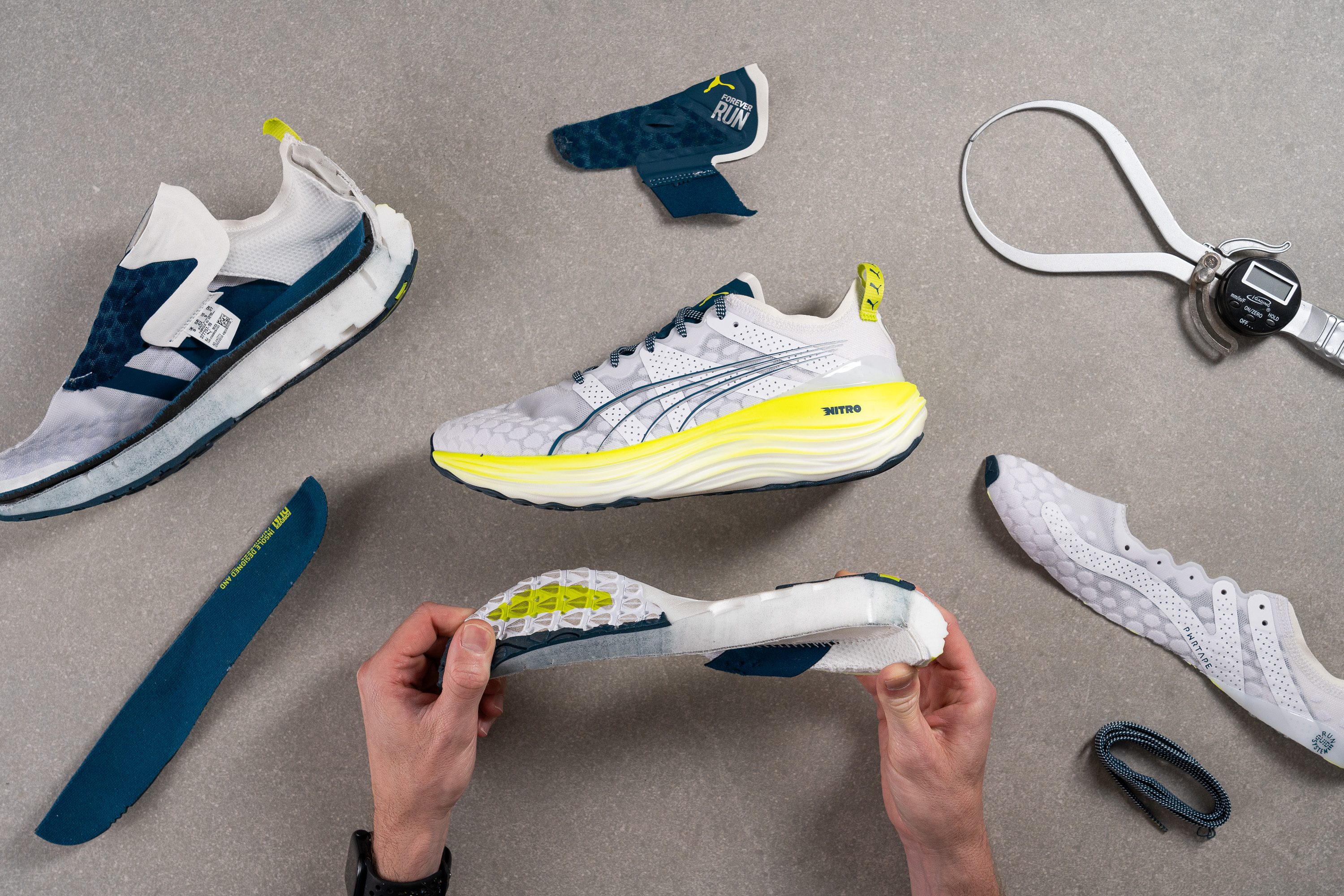
Amortiguación
Shock absorption
Una de las características destacadas de las ForeverRun Nitro es su versatilidad para todo propósito. Con 133 SA en el talón y 108 SA en el antepié, rinden bien tanto en las tiradas fáciles de 5K como en las carreras más largas para aumentar tu resistencia.
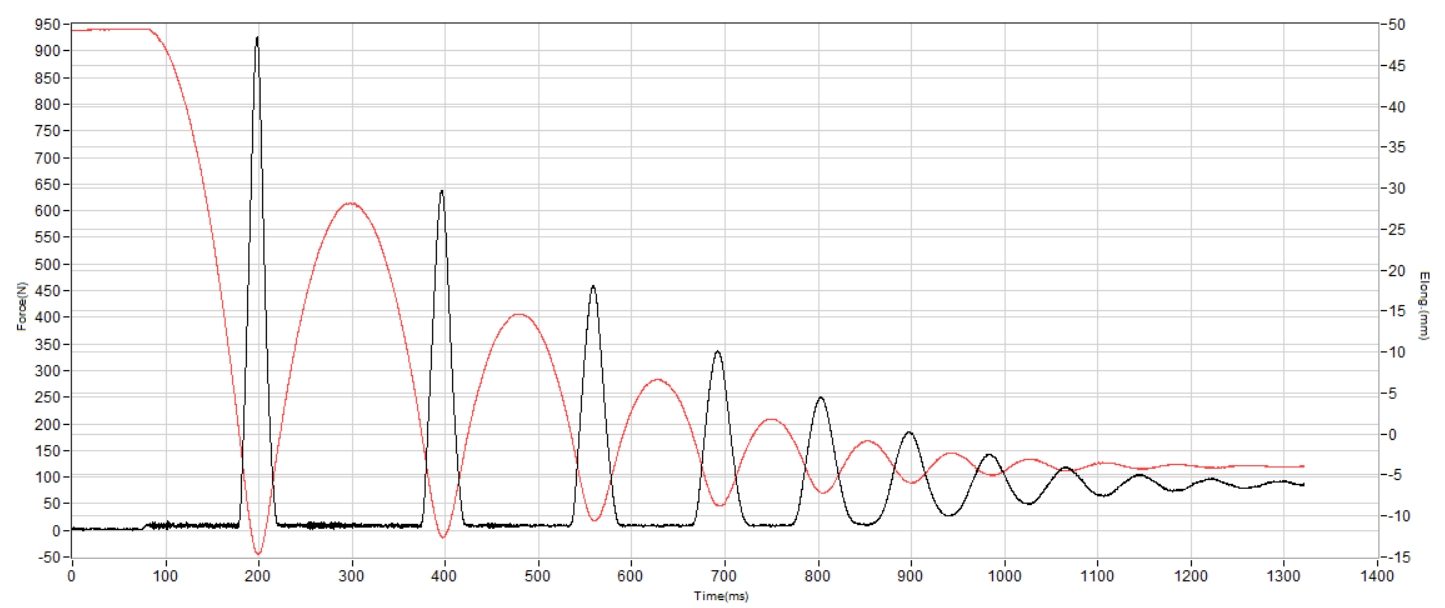
| ForeverRun Nitro | 133 SA |
| Media | 129 SA |
Energy return
El retorno de energía está bien para salir a correr diariamente, pero sí estás buscando el máximo rendimiento, es probable que la mediasuela de estas zapatillas te parezca un poco plana a ritmos rápidos. Lo sentimos en nuestros propios pies durante las pruebas de uso, y pudimos confirmarlo en el laboratorio: un 59,8 % en el talón y un 63,5 % en el antepié no son resultados muy altos.
| ForeverRun Nitro | 59.8% |
| Media | 58.5% |
Altura de la suela en la zona del talón
Estas zapatillas tienen una suela en el talón de 36,1 mm de altura según nuestros calibres y, aunque ofrece una amortiguación considerable, no alcanza los límites de unas verdaderas zapatillas maximalistas.
Aunque puede no parecer tan gigantesco en comparación con años anteriores o al lado de rascacielos como las ASICS Superblast 2, el talón de este modelo nos aseguró que teníamos amortiguación de sobra para caer.
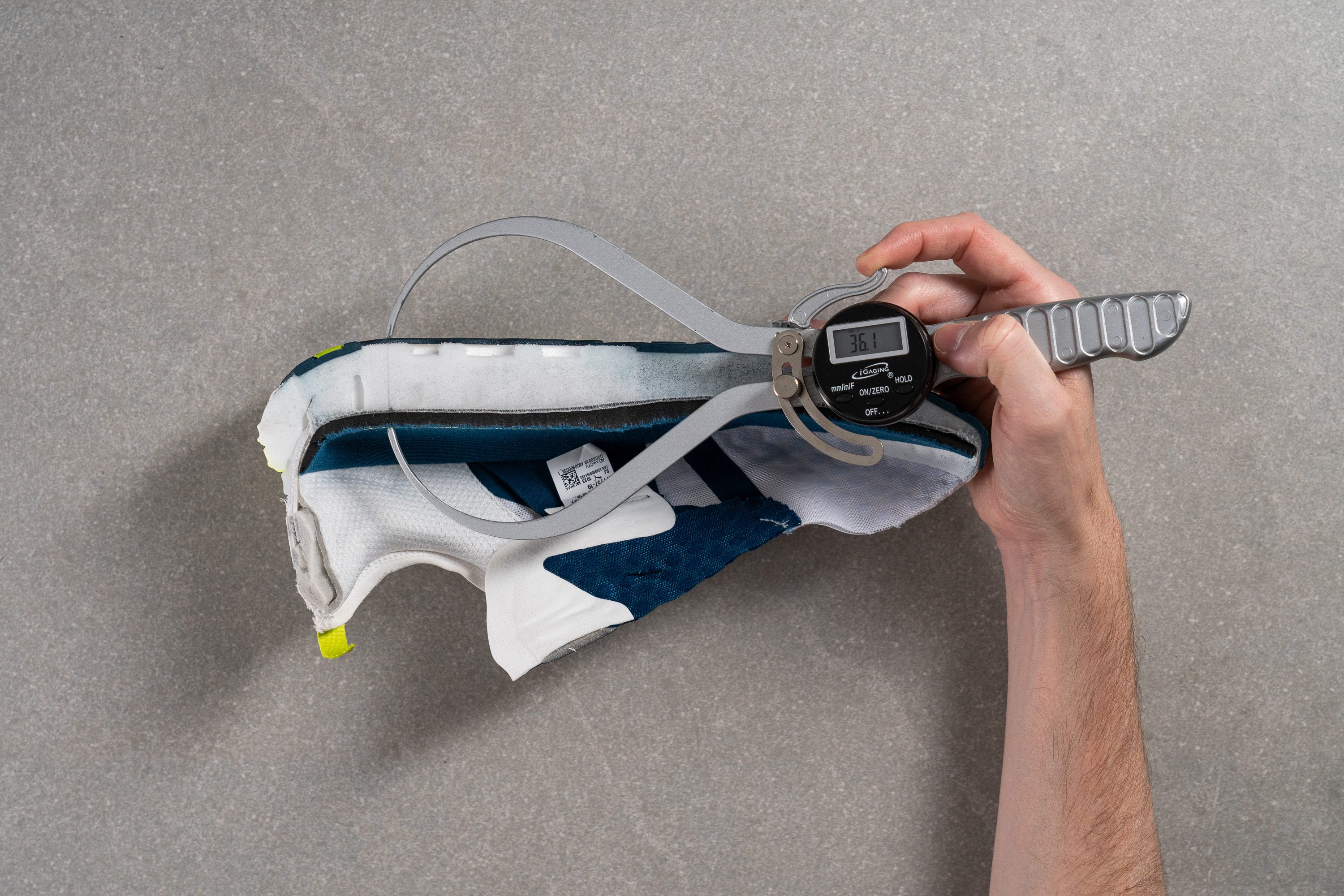
| ForeverRun Nitro | 36.1 mm |
| Media | 34.8 mm |
Altura de la suela en el antepié
Cuando medimos la suela en el antepié, nuestro calibre marcó 26,6 mm, que debería ser suficiente para la mayoría de los corredores. Sin embargo, puede que los corredores de mediopié o de metatarsos, así como los más pesados, prefieran las Saucony Hurricane 24, que tienen una amortiguación más generosa y un acolchado más grueso en el antepié para mejorar la comodidad.
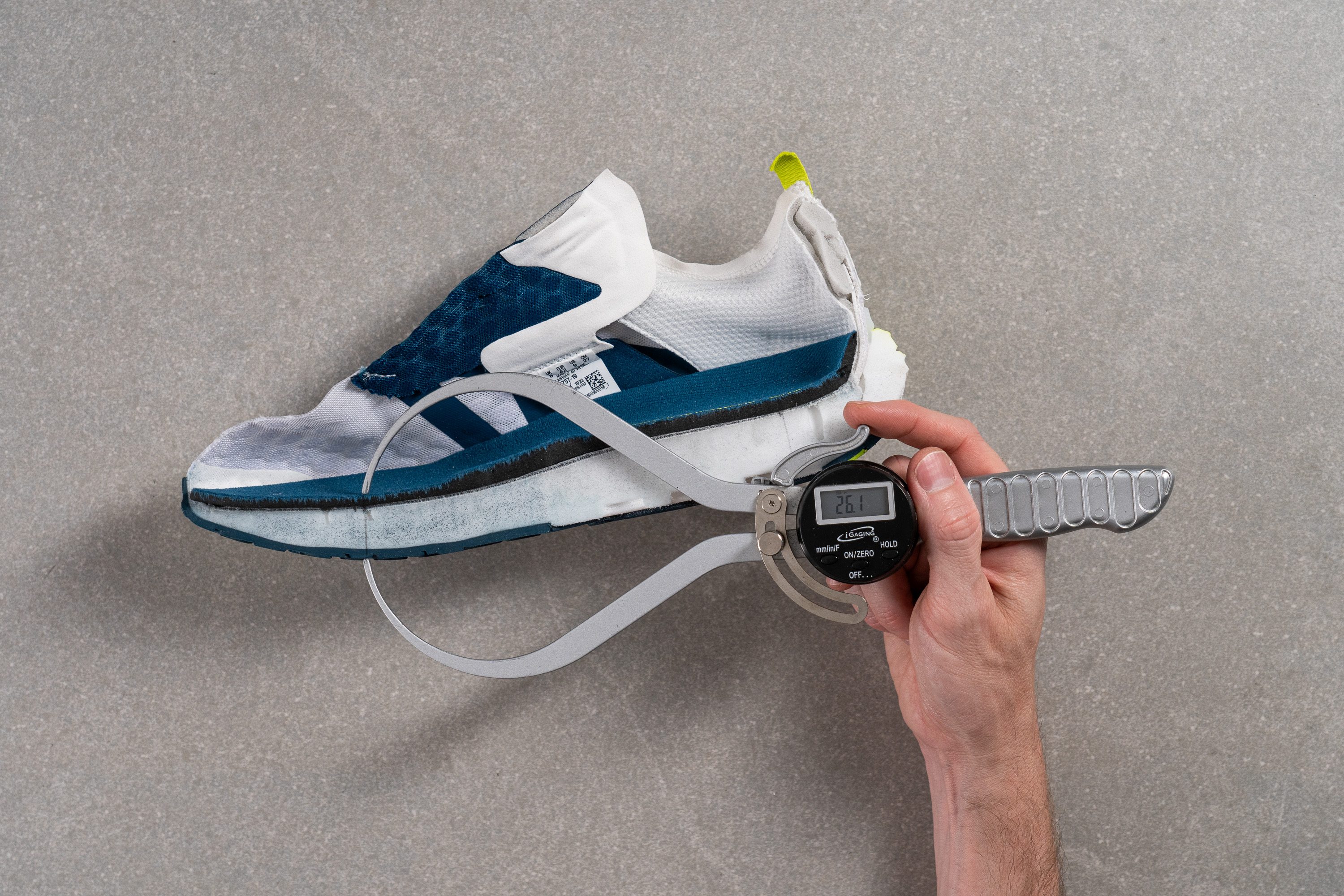
| ForeverRun Nitro | 26.1 mm |
| Media | 26.2 mm |
Drop
PUMA afirma que este modelo tiene un drop de 10 mm, y a nosotros nos dio lo mismo en el laboratorio. Esta precisión es un caso muy poco común, ¡así que le damos nuestra enhorabuena a la marca!
El drop de 10 mm suele considerarse como una opción versátil para unas zapatillas para correr a diario. Normalmente, los talonadores son su mejor público, pero es lo suficientemente versátil como para adaptarse a varios tipos de corredores. ¡Nos parece una decisión muy acertada para estas zapatillas!
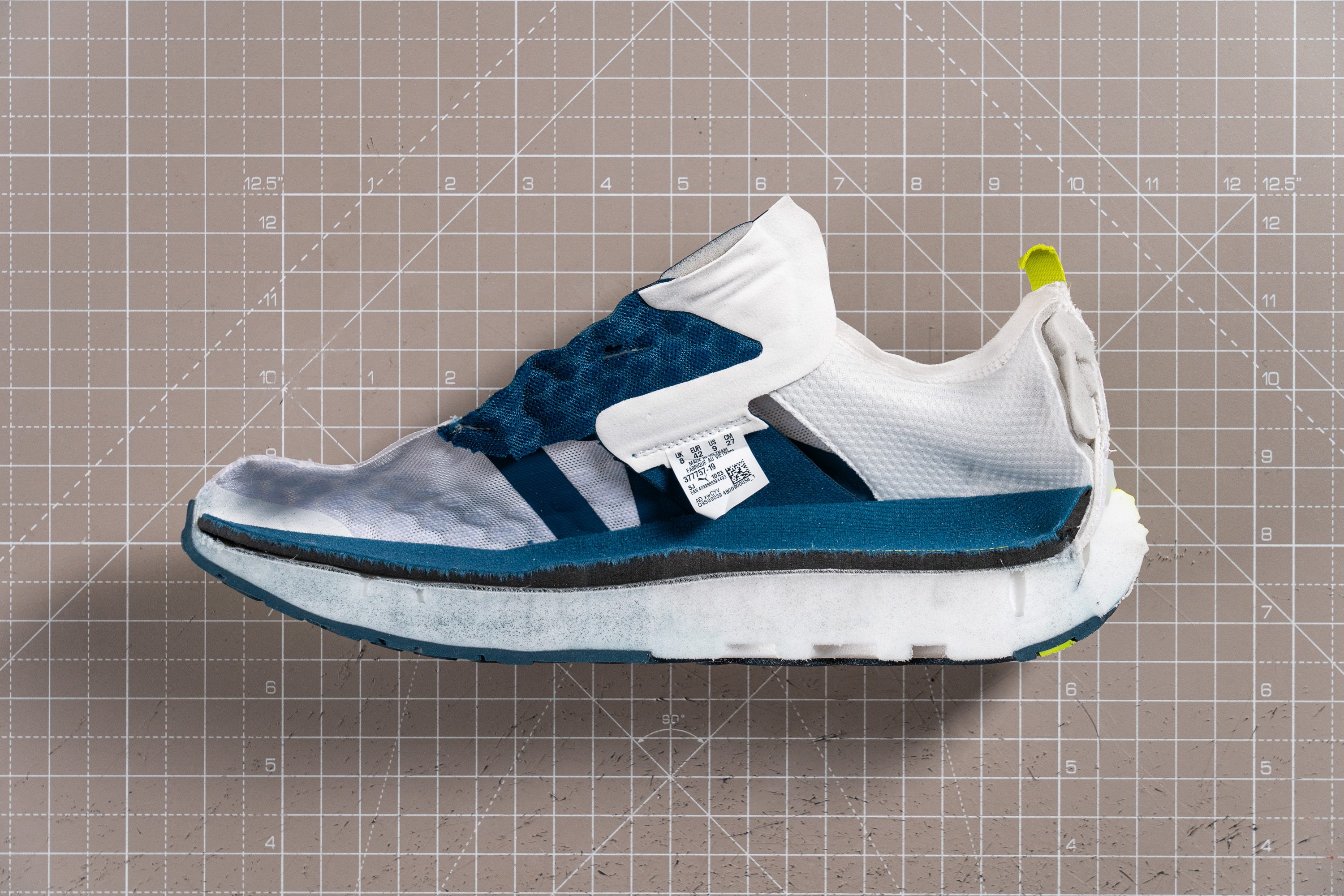
| ForeverRun Nitro | 10.0 mm |
| Media | 8.6 mm |
Suavidad de la mediasuela
Una clara ventaja de las zapatillas de entrenamiento de PUMA en comparación con las demás es su mediasuela Nitro, ya que su espuma inflada con nitrógeno suele superar a la mayoría de los compuestos de entrenamiento de otras marcas.
En las ForeverRun Nitro, descubrimos una espuma bien equilibrada que no es demasiado mullida, lo que nos parece una buena elección para un modelo que está diseñando pensando en la estabilidad. Aunque las espumas más blandas pueden ser tentadoras, a lo mejor traen consigo una pisada inestable.
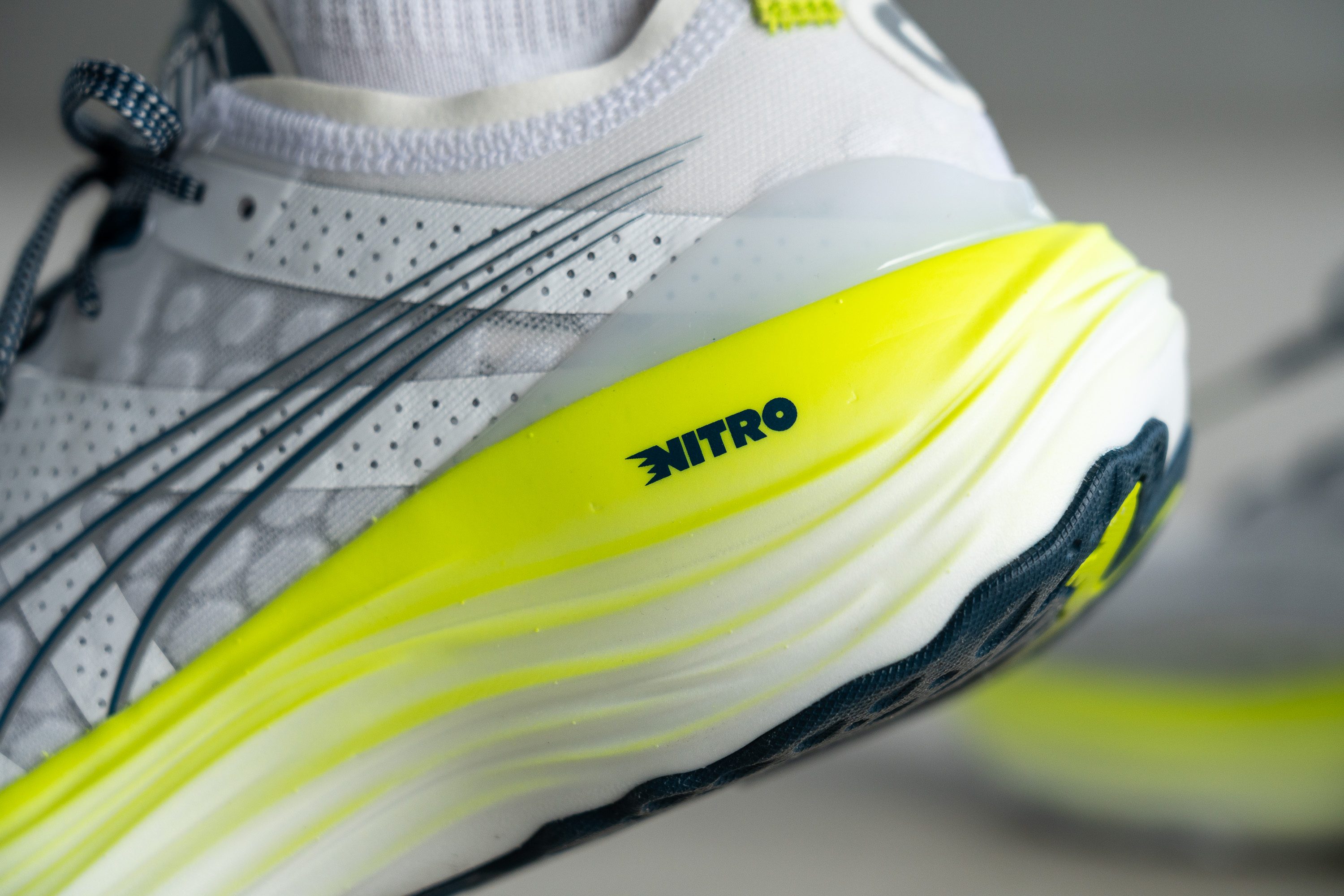
El retorno de energía en este modelo de entrenamiento está muy bien, pero ni de lejos se acerca al de las Deviate Nitro Elite 2, por ejemplo.
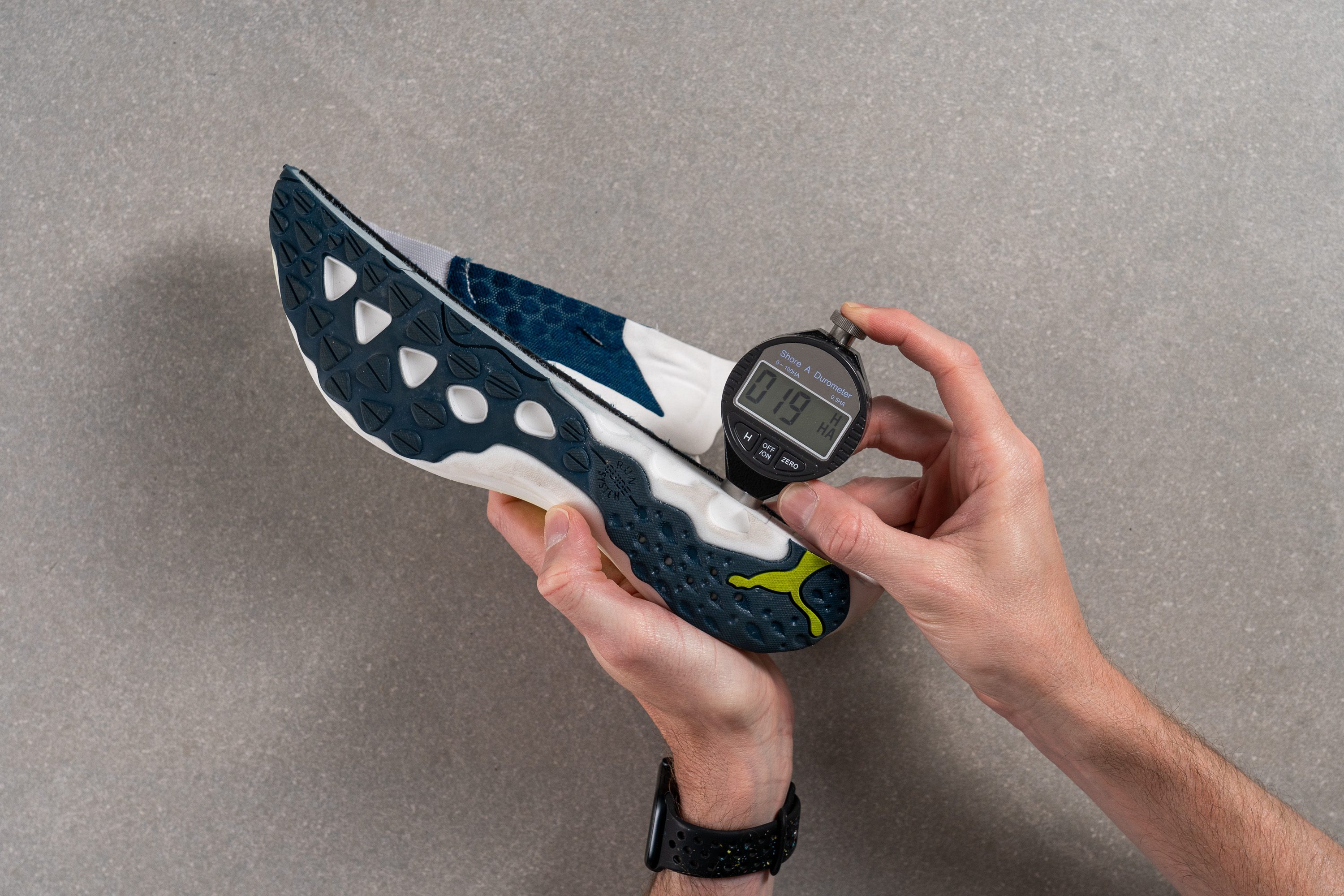
| ForeverRun Nitro | 19.1 HA |
| Media | 20.4 HA |
Tallaje y ajuste
Talla
Las PUMA ForeverRun Nitro tallan bien (110 votos).
Width / Fit
The fit isn't particularly roomy, but it isn't excessively narrow either.
Our initial measurement at the widest part of the upper showed 97.9 mm—just about average. This felt typical to us during our runs too. However, the shoe’s low-volume upper makes it less suitable for those with larger feet, as demonstrated in the video above.

En esta prueba se utiliza una metodología antigua, así que no verás las zapatillas que hemos analizado últimamente en la tabla. Los resultados obtenidos con metodologías distintas no se pueden comparar.
| ForeverRun Nitro | 97.9 mm |
| Media | 98.5 mm |
Toebox width
Our second measurement at the big toe area also showed a standard reading of 77.9 mm, indicating a regularly tapered toebox that should fit most runners comfortably.

Of course, don't expect the spacious, foot-shaped design typical of Altra shoes. It's far away from that.
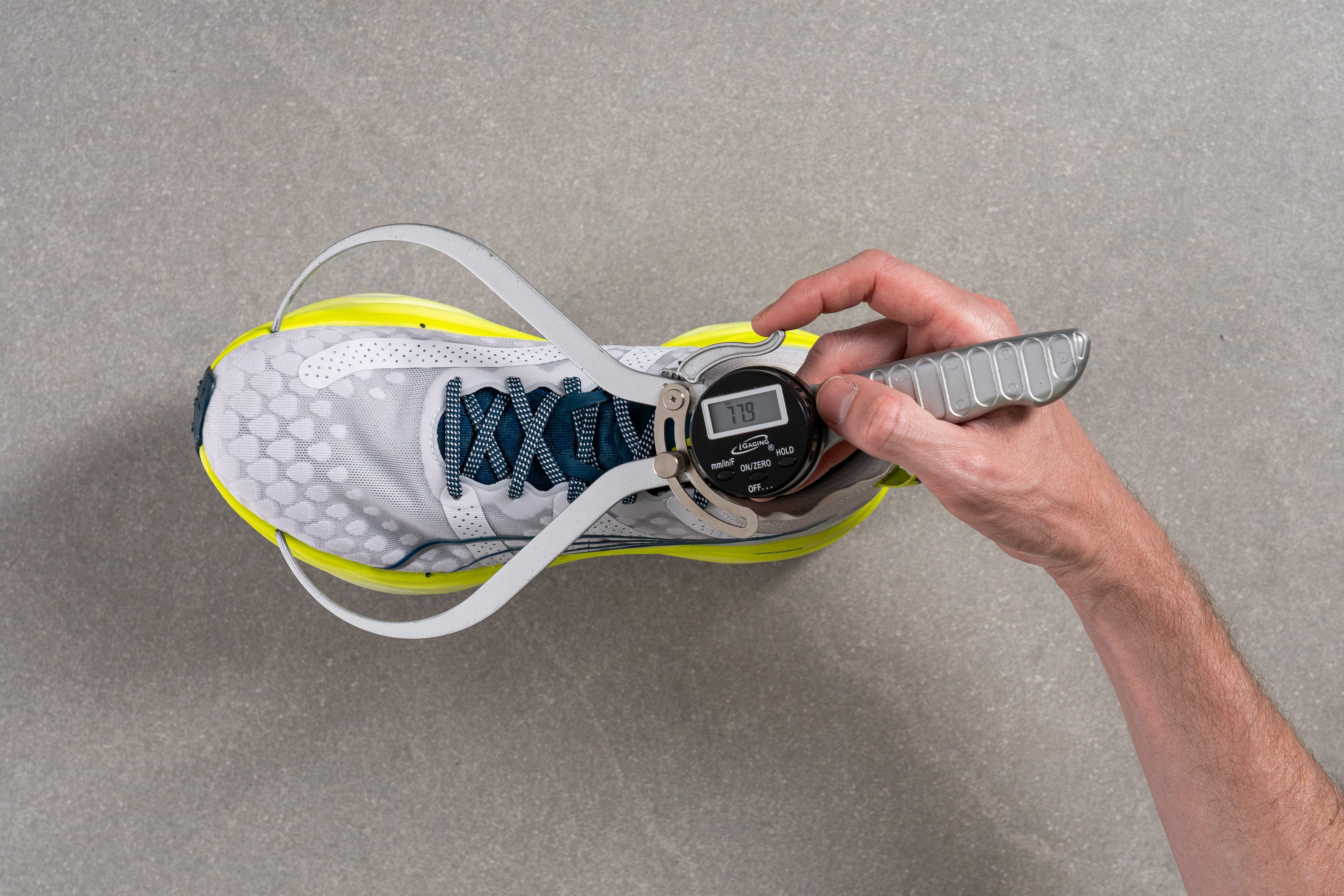
En esta prueba se utiliza una metodología antigua, así que no verás las zapatillas que hemos analizado últimamente en la tabla. Los resultados obtenidos con metodologías distintas no se pueden comparar.
| ForeverRun Nitro | 77.9 mm |
| Media | 78.4 mm |
Tracción / Agarre
Traction test
Cuando analizamos las ForeverRun Nitro, se llevaron un impresionante 0,61 en nuestra prueba de tracción. Este resultado tan alto confirma que ofrecen un agarre excelente incluso en superficies mojadas. Aunque, sinceramente, tampoco es algo que nos sorprenda, ya que estas zapatillas cuentan con el maravilloso caucho PumaGrip.
| ForeverRun Nitro | 0.61 |
| Media | 0.48 |
Diseño de la suela exterior
La cobertura de caucho es buena en comparación con otras zapatillas, aunque toda la espuma expuesta en la cara interna no es algo que solamos ver en unas zapatillas de estabilidad.
El diseño de la suela exterior parece muy elaborado, quizás hasta el punto de ser excesivamente complejo. Mezcla pequeños huecos con tacos chiquitines que parece que están inspirados en la huella de un puma, además de que las formas son distintas. ¡Y además tienen el logo de la marca en el talón!
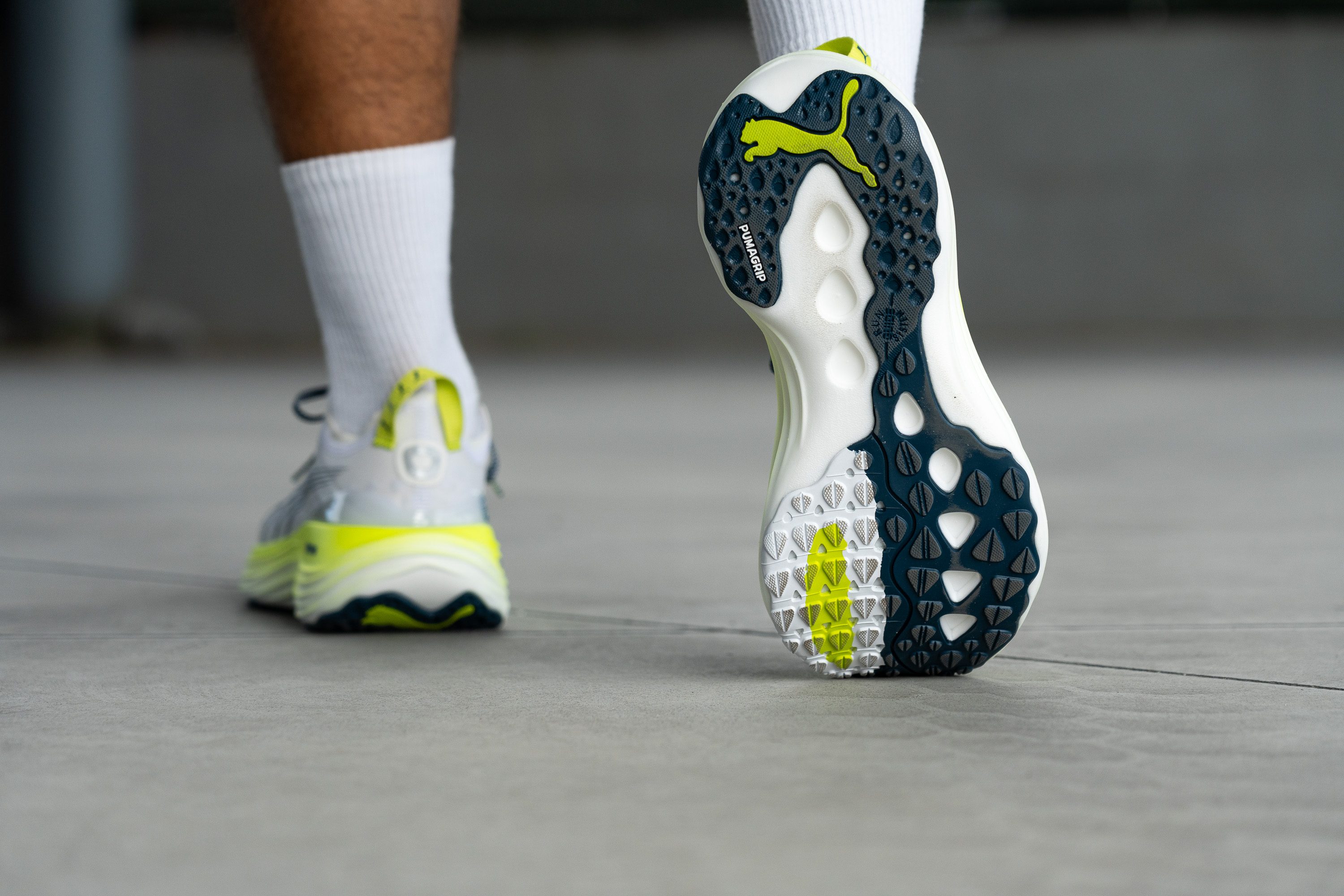
Flexibilidad / Rigidez
Mientras les hacíamos pruebas, nos dimos cuenta de que las ForeverRun Nitro se sienten más como unas zapatillas neutras de entrenamiento diario que como unas zapatillas de estabilidad tradicionales, y los resultados de nuestra prueba de rigidez longitudinal lo confirman.
Solo necesitaron 12,8 N para doblarse 30 grados, dejándonos claro que son ideales para las personas que están buscando un par cómodo que también les sirva para hacer otras actividades.
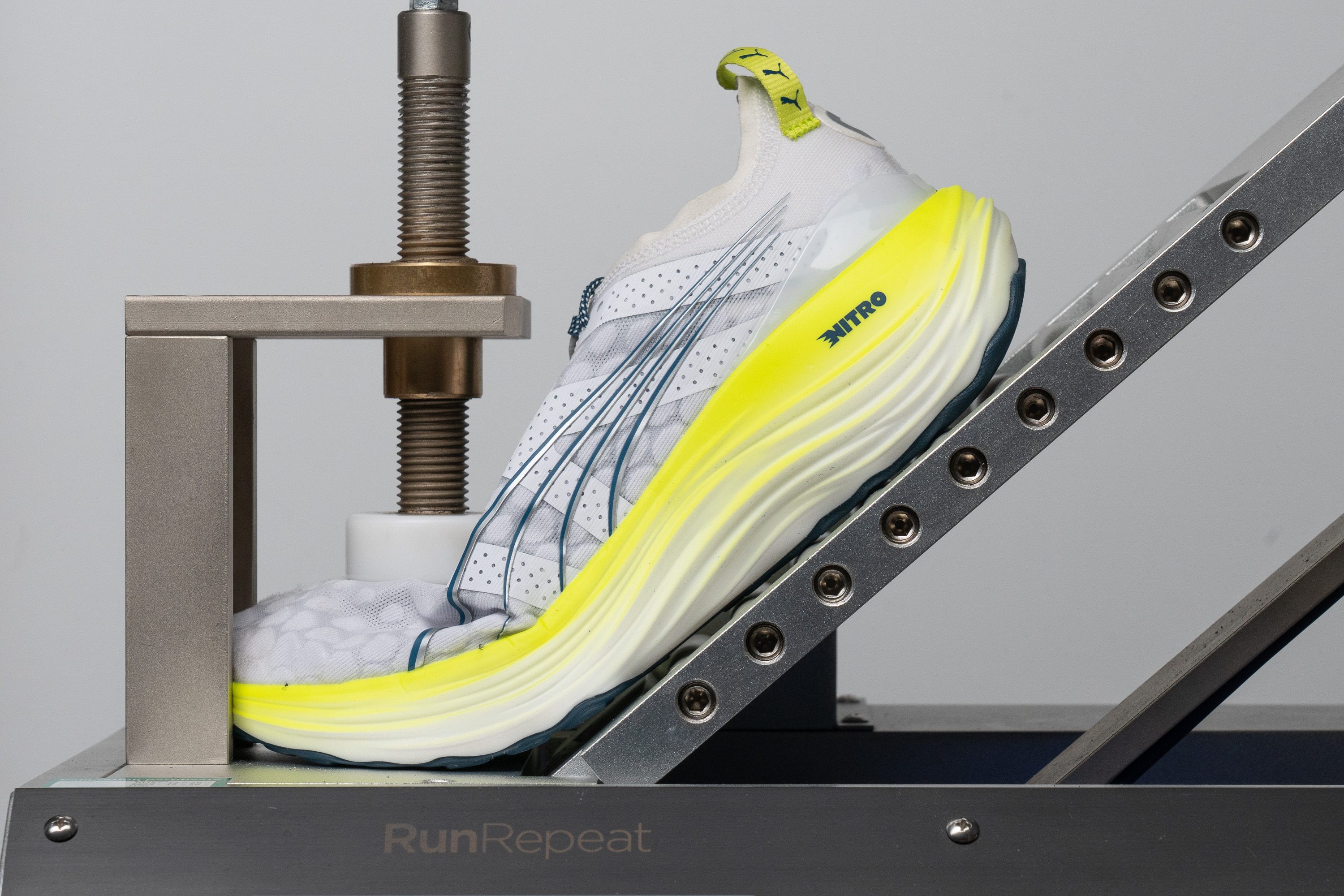
| ForeverRun Nitro | 12.8N |
| Media | 15.3N |
Rigidez en frío (%)
En esta ocasión, la Nitro no rindió bien a bajas temperaturas, ya que se volvió un 39,5 % más rígida en nuestra prueba de flexión a 90 grados. Sinceramente, es un resultado decepcionante para este caucho.
| ForeverRun Nitro | 40% |
| Media | 33% |
Peso
Cuando las ves por primera vez, las ForeverRun Nitro parecen unas zapatillas grandotas y pesadas.
Sin embargo, en cuanto las subimos a nuestra báscula y nos las pusimos para salir a correr, nos dimos cuenta de que eran bastante más ligeras de lo que parece. Con un peso de tan solo 274 g, PUMA ha conseguido hacer que este modelo pierda un montón de peso.
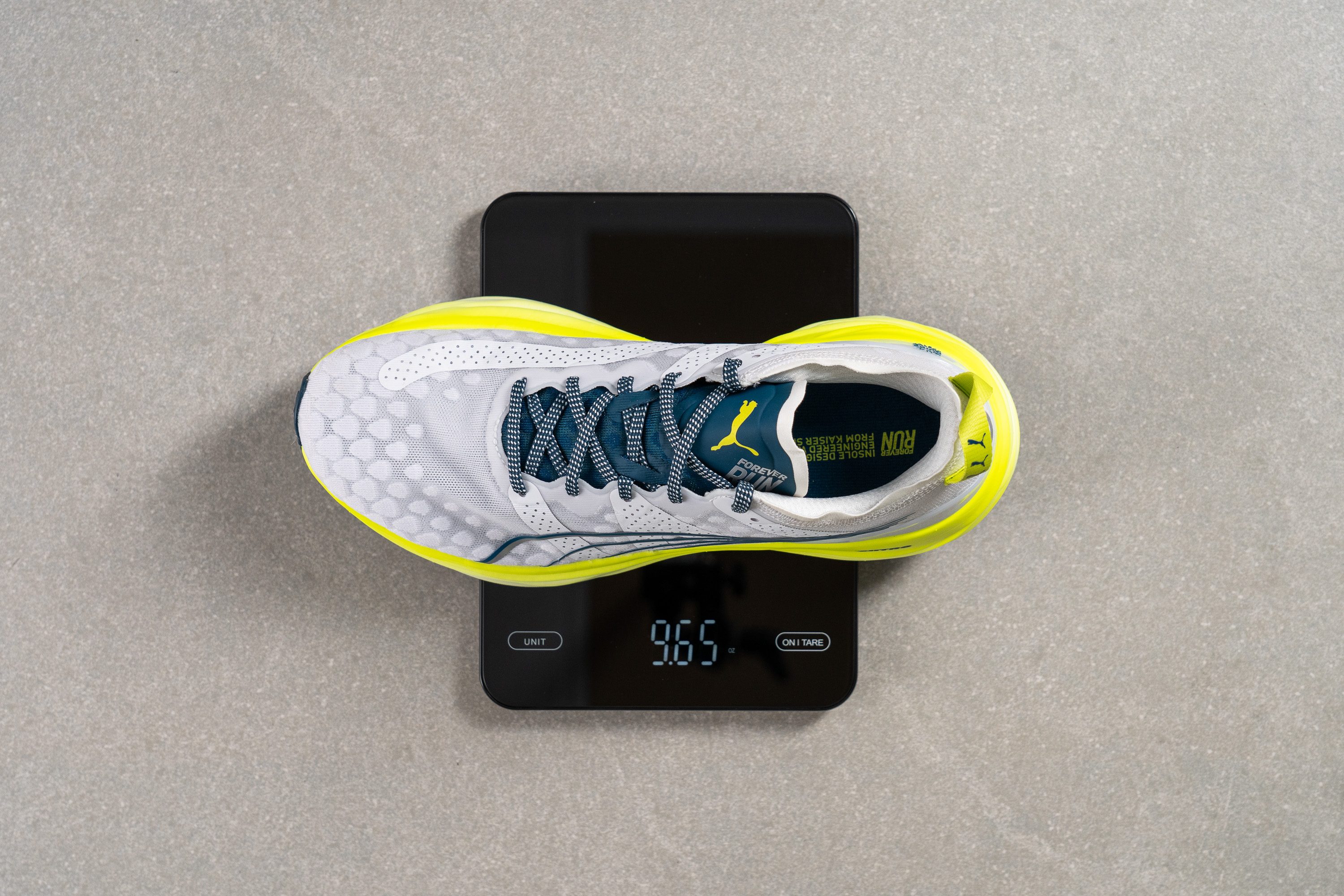
| ForeverRun Nitro | 9.7 oz (274g) |
| Media | 9.3 oz (264g) |
Transpirabilidad
Una de las cosas que más nos gusta de PUMA (y que mencionaremos más de una vez en este análisis) es que pasa de las modas, creando zapatillas que normalmente destacan. La parte superior de malla de las ForeverRun Nitro, con su diseño único, es un claro ejemplo.
Preocupados por cómo podrían afectar a la transpirabilidad las pequeñas almohadillas acolchadas y diseñadas para mejorar la comodidad que estas zapatillas tienen en el antepié, empezamos nuestras pruebas con la máquina de humo, pero nada, falsa alarma, ¡nos quedamos tan contentos con su rendimiento que decidimos darles un merecido 4/5!
Cuando iluminamos el upper con nuestra luz pudimos ver mejor las almohadillitas de las que hablábamos antes y los refuerzos PWRTAPE. Pero no te preocupes, que ninguna de estas dos cosas dificultó la evacuación del calor o de la humedad.
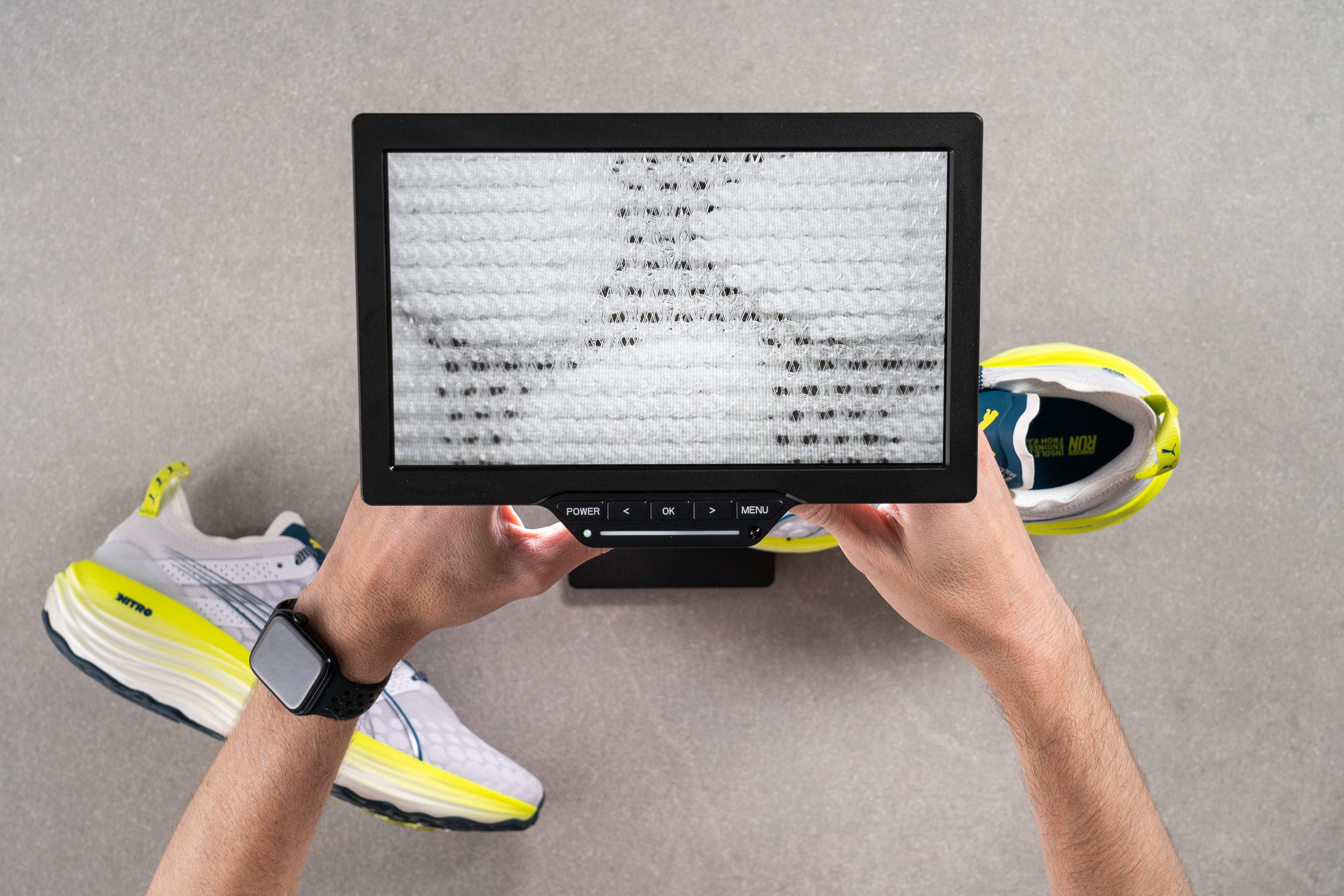
PUMA ha espaciado hábilmente estas piezas para que el flujo de aire sea adecuado, y nuestro microscopio lo confirmó. La verdad es que nos hemos quedado impresionados con la precisión de este diseño.
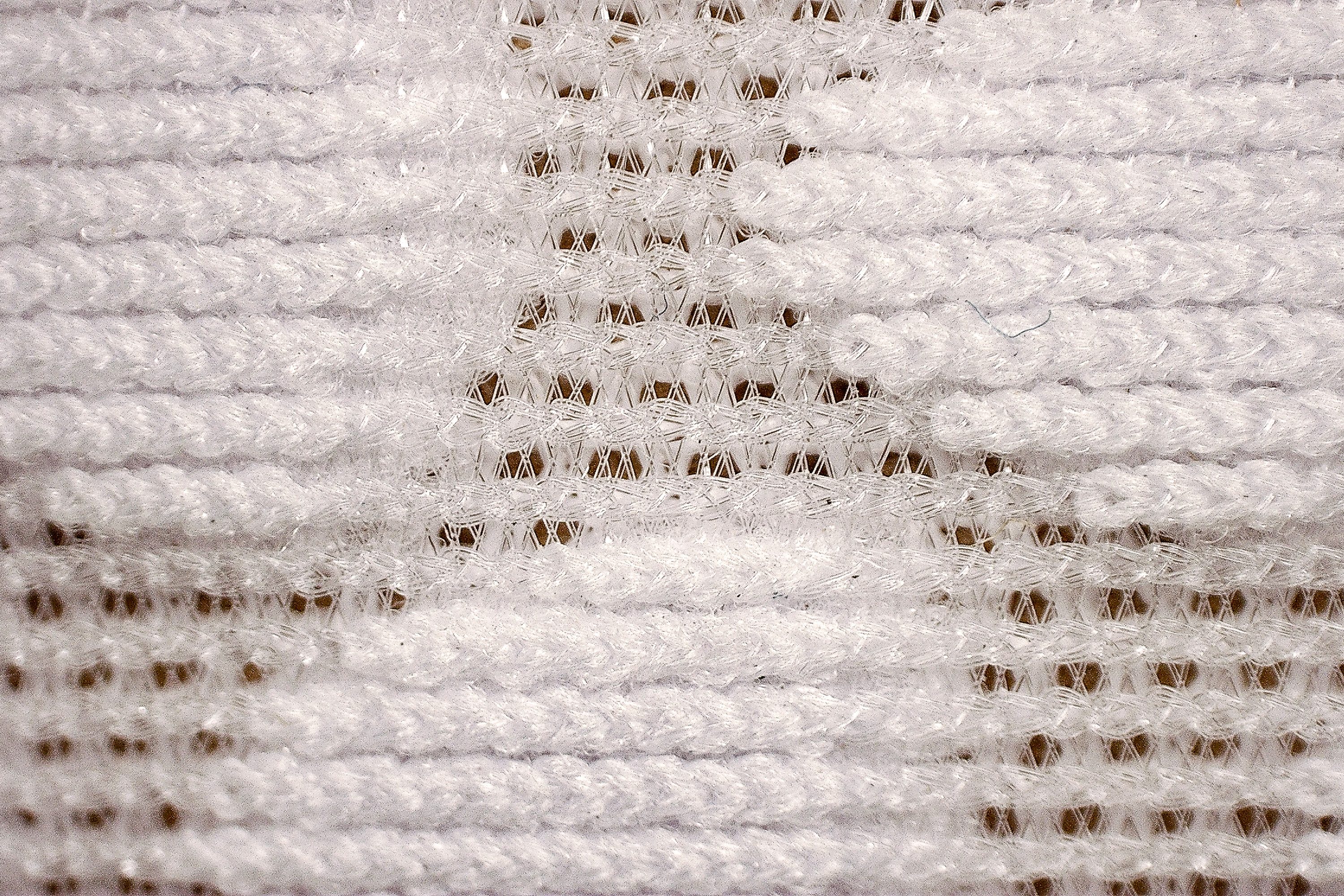
La parte superior de estas PUMA se ha fabricado intencionadamente sin demasiado acolchado. Esto sugiere que la marca se ha centrado en reducir el peso, así como en los corredores que priorizan los uppers ligeros y finitos.
Otra característica interesante de este modelo son los refuerzos PWRTAPE perforados de su parte superior. Estas mejoras garantizan la transpirabilidad sin sacrificar la sujeción, y eso nos encanta.

| ForeverRun Nitro | 4 |
| Media | 3.7 |
Estabilidad
Prueba de estabilidad lateral
Las ForeverRun Nitro se venden como unas zapatillas de estabilidad, y nosotros estamos de acuerdo. La verdad es que dan totalmente en el clavo, y tienen todas las ventajas de las zapatillas de estabilidad modernas que no son intrusivas. Es más, ¡creemos que hasta van un paso más allá!
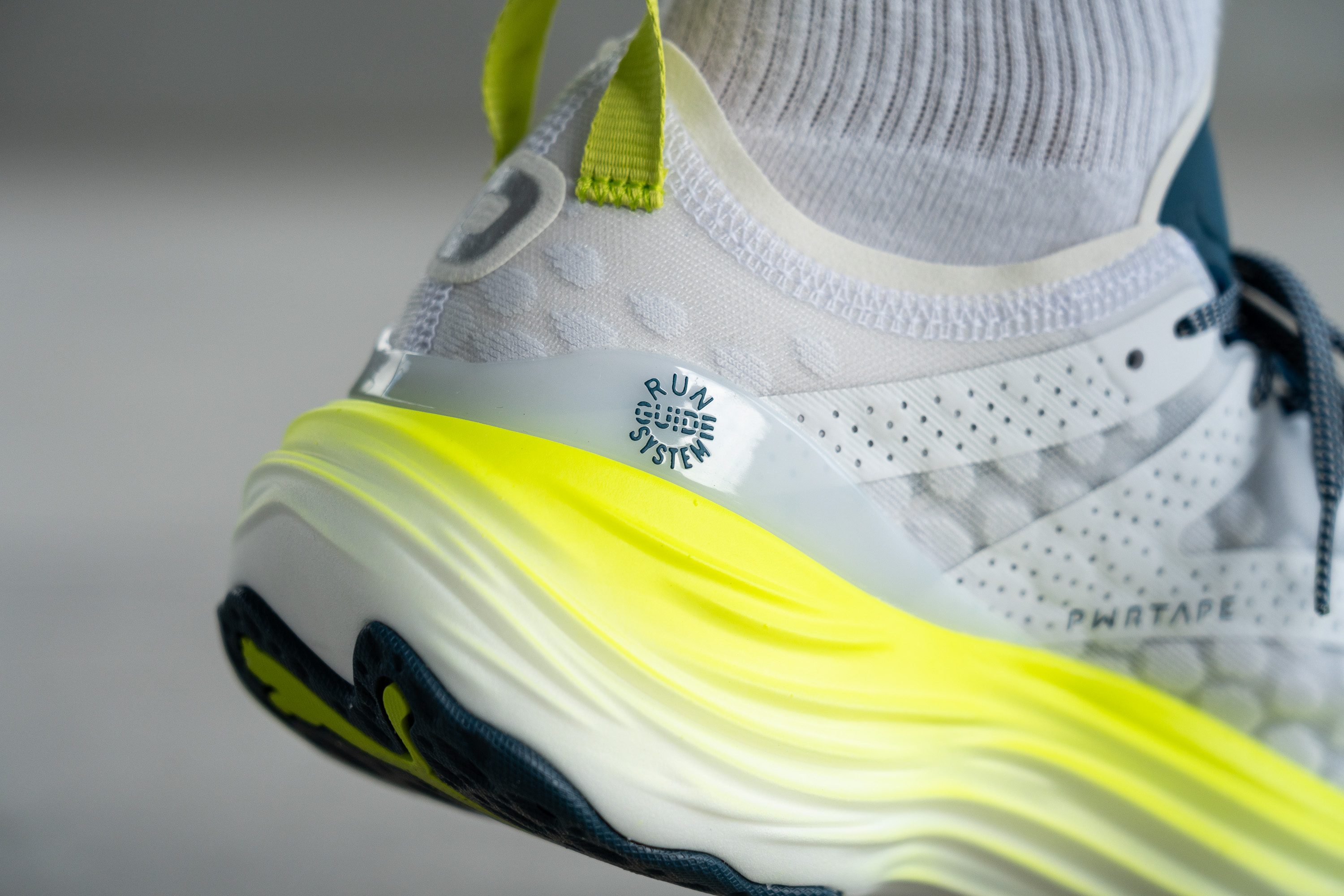
Descubrimos que PUMA utiliza lo que llama el RunGuide System, que es básicamente una forma muy chula de decir que son unas zapatillas estables sin refuerzos en la cara interna ni otros elementos intrusivos. Lo consiguen utilizando técnicas como los refuerzos PWRTAPE, un contrafuerte de plástico duro en el talón y una enorme extensión en la suela que hace que el pie no se mueva de su sitio, proporcionando una base de aterrizaje muy amplia.
Rigidez torsional
Nos sorprendió descubrir que las ForeverRun Nitro no tienen una rigidez torsional demasiado elevada, ya que se han llevado solo un 3/5 en esta prueba, que es algo poco común entre las zapatillas de estabilidad. Esto podría explicar por qué las sentimos como si fuesen unas zapatillas de entrenamiento diario en términos de comodidad, pero ofreciendo a su vez una estabilidad excelente.
| ForeverRun Nitro | 3 |
| Media | 3.5 |
Rigidez del contrafuerte del talón
Si la prueba anterior nos sorprendió, esta segunda ya sí que hizo que pestañeásemos 50 veces. La verdad es que encontrarnos con un contrafuerte del talón así de flexible en unas zapatillas centradas en la sujeción es algo muy poco común. El 2/5 que se ha llevado el de este modelo nos indica claramente que PUMA tiene la intención de hacer las cosas de manera distinta, alejándose de los diseños que utilizan las demás marcas.
Por eso estas zapatillas nos parecen ideales para los corredores que tienen tendones de Aquiles sensibles o que tienen el síndrome de Haglund, ya que esta zona es más mullida y flexible.
| ForeverRun Nitro | 2 |
| Media | 2.9 |
Anchura de la mediasuela - antepié
La mediasuela de las ForeverRun Nitro es gigantesca, sobre todo en el antepié, que mide 121,1 mm.
Este resultado es típico en las zapatillas de estabilidad, mejorando mucho su rendimiento. Cuando corrimos con estas PUMA disfrutamos de su estable plataforma de aterrizaje, aumentando nuestra confianza en cada paso y durante toda la transición.

| ForeverRun Nitro | 121.3 mm |
| Media | 114.4 mm |
Anchura de la mediasuela - talón
Las ForeverRun Nitro se distinguen de la mayoría de las zapatillas de estabilidad modernas por tener un mediopié estrecho. A diferencia de otras, como las Hoka Gaviota 5, que son anchas en general, las FRN se estrechan bastante en el mediopié antes de que el talón se expanda de nuevo, alcanzando unos anchísimos 101,8 mm en la zona del retropié.
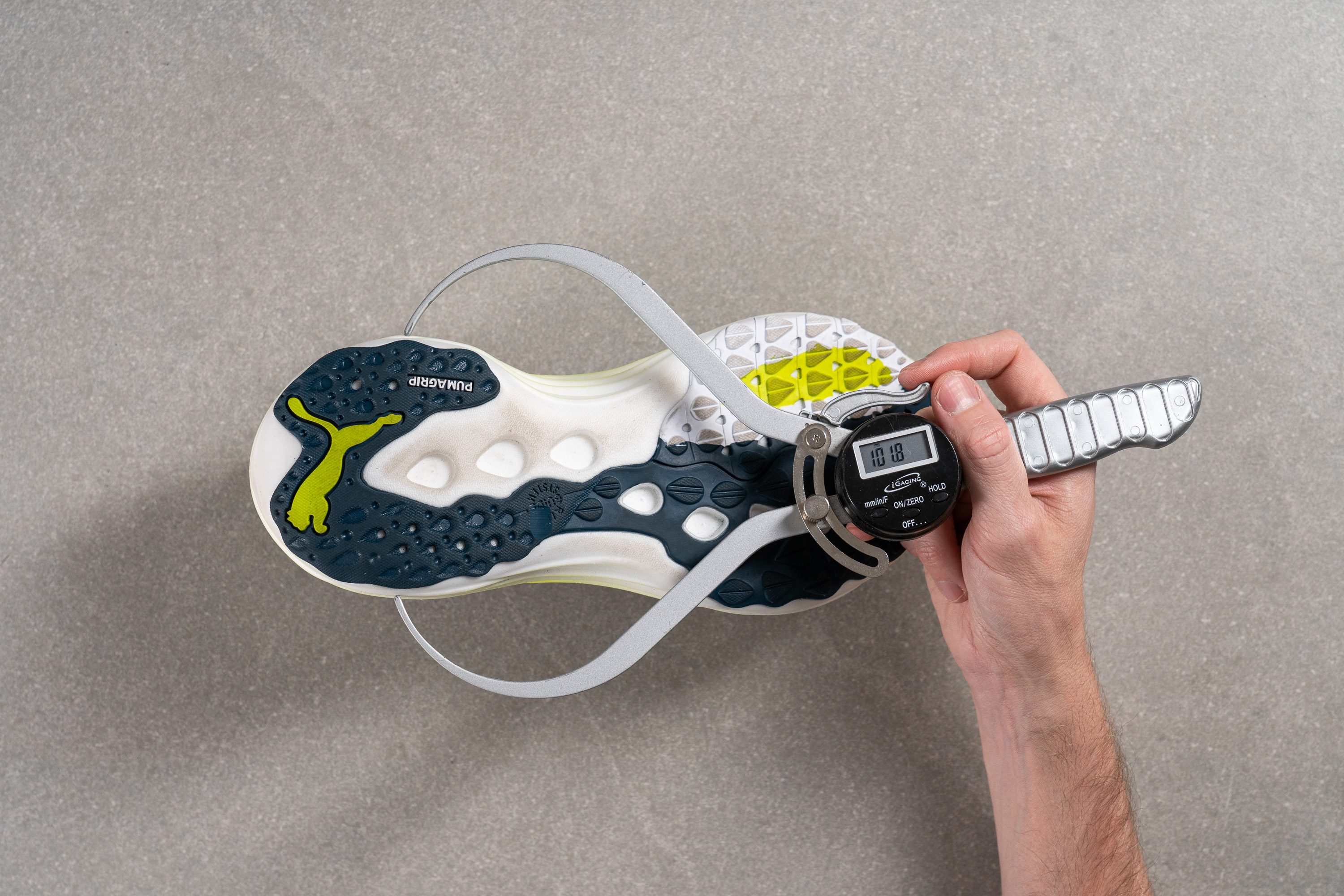
| ForeverRun Nitro | 101.8 mm |
| Media | 90.7 mm |
Durabilidad
Durabilidad de la parte delantera
En teoría, estas piececitas acolchadas también deberían mejorar la durabilidad de las ForeverRun Nitro, pero eso tendrá que decírnoslo nuestro Dremel.
La verdad es que los resultados fueron bastante prometedores. Aunque el 3/5 que les dimos no suena a nada espectacular, sin duda es un resultado positivo para cualquier par de zapatillas de running para correr por asfalto. Esto vuelve a confirmar que el diseño único de PUMA no solo es bonito, sino que además está hecho para durar.

| ForeverRun Nitro | 3 |
| Media | 2.6 |
Durabilidad del acolchado del talón
Desafortunadamente, el acolchado del talón nos dejó con ganas de más, además de que sí sentimos algo de deslizamiento del talón, lo que podría volverse una preocupación importante para muchos corredores. Nuestra recomendación es que te pongas los calcetines más mullidos y con mejor agarre que tengas para intentar remediarlo.
También descubrimos que el Dremel destrozó más esta zona de lo que nos esperábamos, así que no pudimos darles más que un 2/5 en durabilidad del acolchado del talón a estas zapatillas.
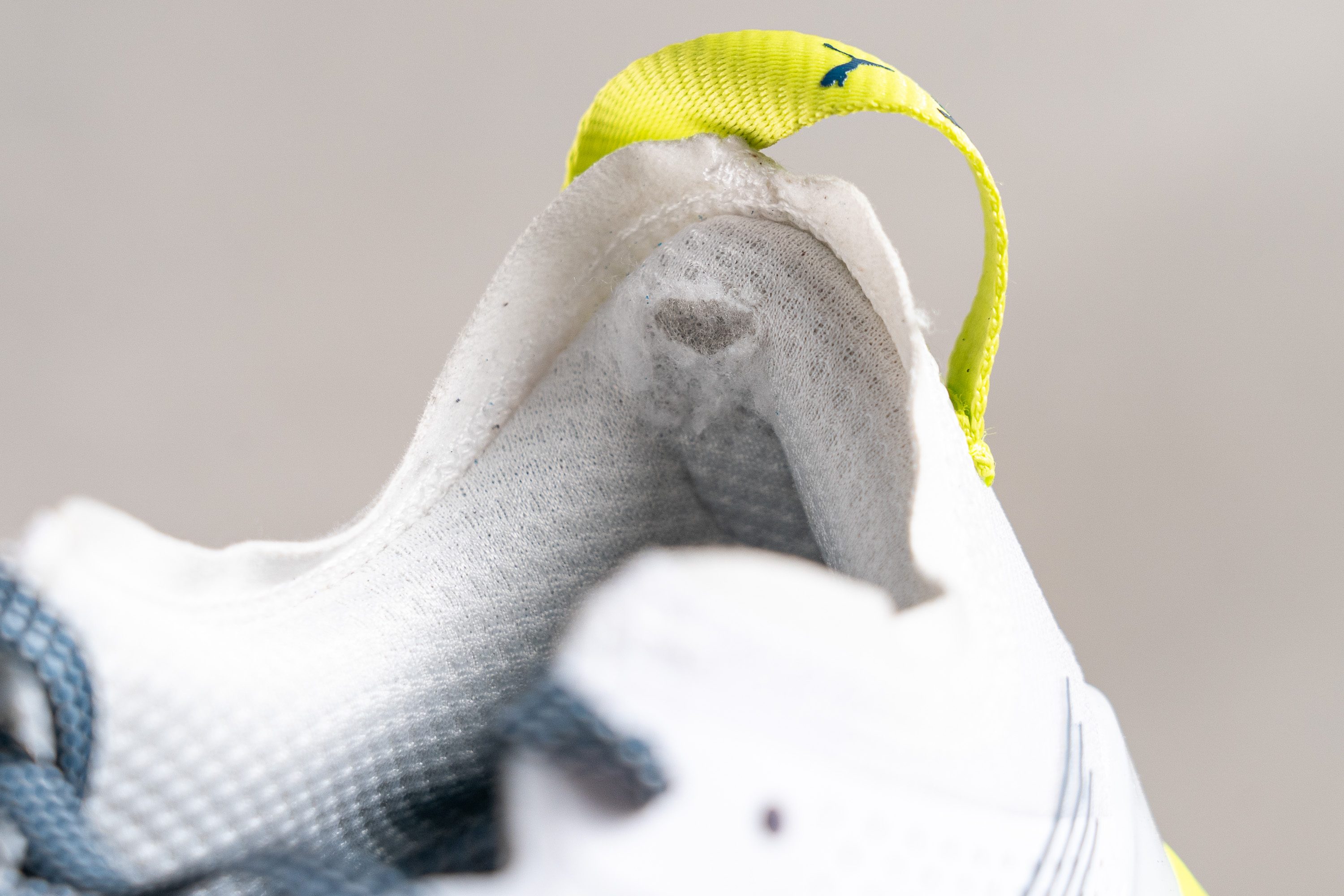
| ForeverRun Nitro | 2 |
| Media | 3.4 |
Dureza de la suela
Apostamos fuerte por la suela exterior de este par ya que, en los últimos años, PUMAGRIP ha consolidado su reputación como uno de los compuestos de caucho de más alto nivel del mercado, alzándose junto a pesos pesados como Vibram y Continental.
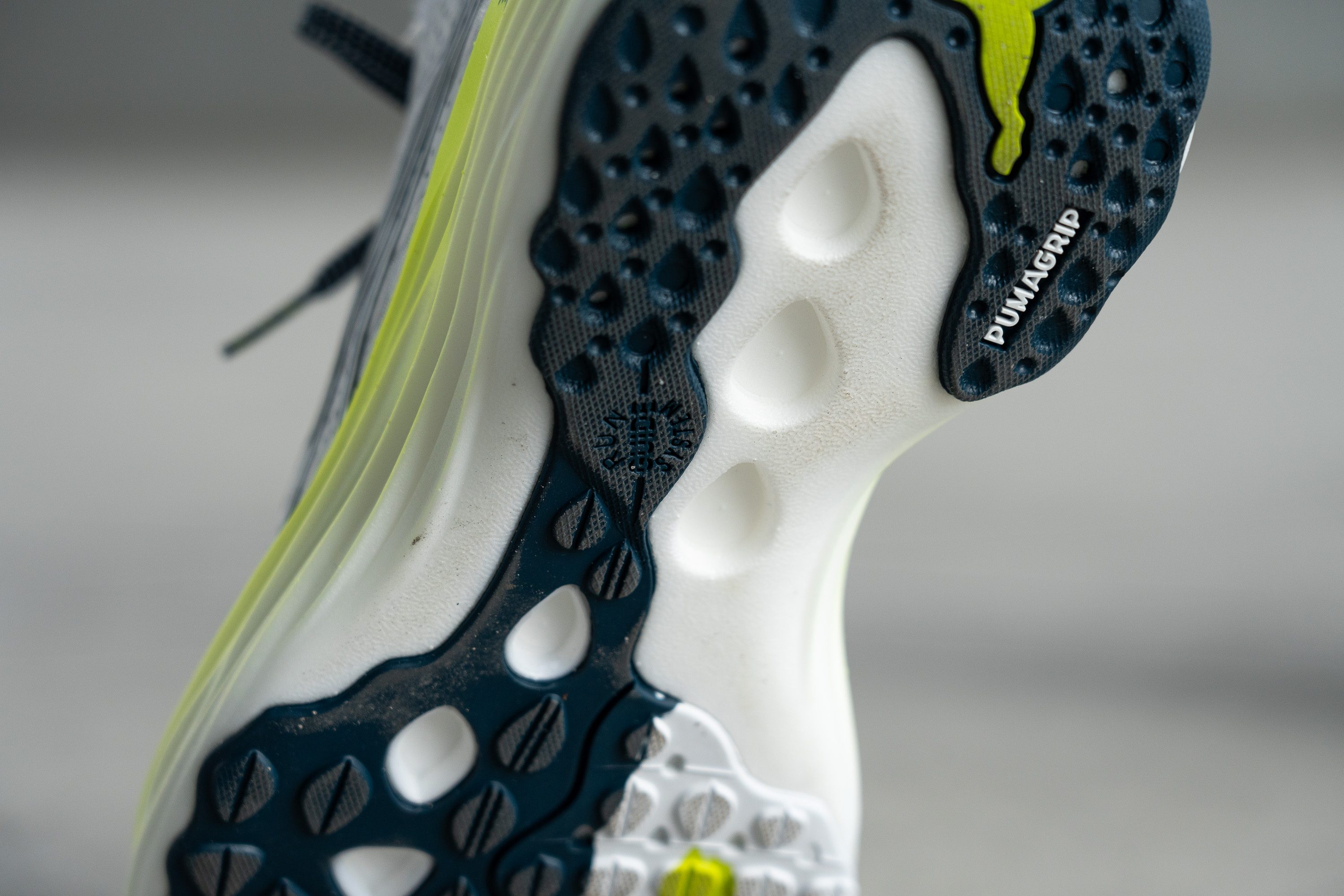
La suela exterior no nos decepcionó en cuanto a agarre, ya que fue muy eficaz tanto sobre superficies secas como mojadas, proporcionando una buena tracción. Nos recordó a nuestra experiencia con otros modelos de PUMA como las Deviate Nitro 3.

El diseño de la suela exterior parece muy elaborado, quizás hasta el punto de ser excesivamente complejo. Mezcla pequeños huecos con mini tacos que parecen inspirados en la huella de un puma, además de que las formas son distintas. ¡Y el logo de la marca está adornando el talón!
Por último, también nos sorprendió que nuestro durómetro marcase 75,3 HC, que es una cifra ligeramente inferior a lo que habíamos previsto. Por lo tanto, esto podría afectar negativamente a la durabilidad de este compuesto.

| ForeverRun Nitro | 75.3 HC |
| Media | 79.2 HC |
Durabilidad de la suela
Aunque la suela exterior tiene un agarre digno de las garras de un puma, se queda corta en lo que a durabilidad respecta.
En nuestra prueba Dremel, medimos unos daños de 1,8 mm de profundidad, que es casi el doble que la media. La verdad es que es un resultado decepcionante para el caucho PUMAGRIP, pero nos esperábamos algo así después de ver el resultado de nuestro durómetro.
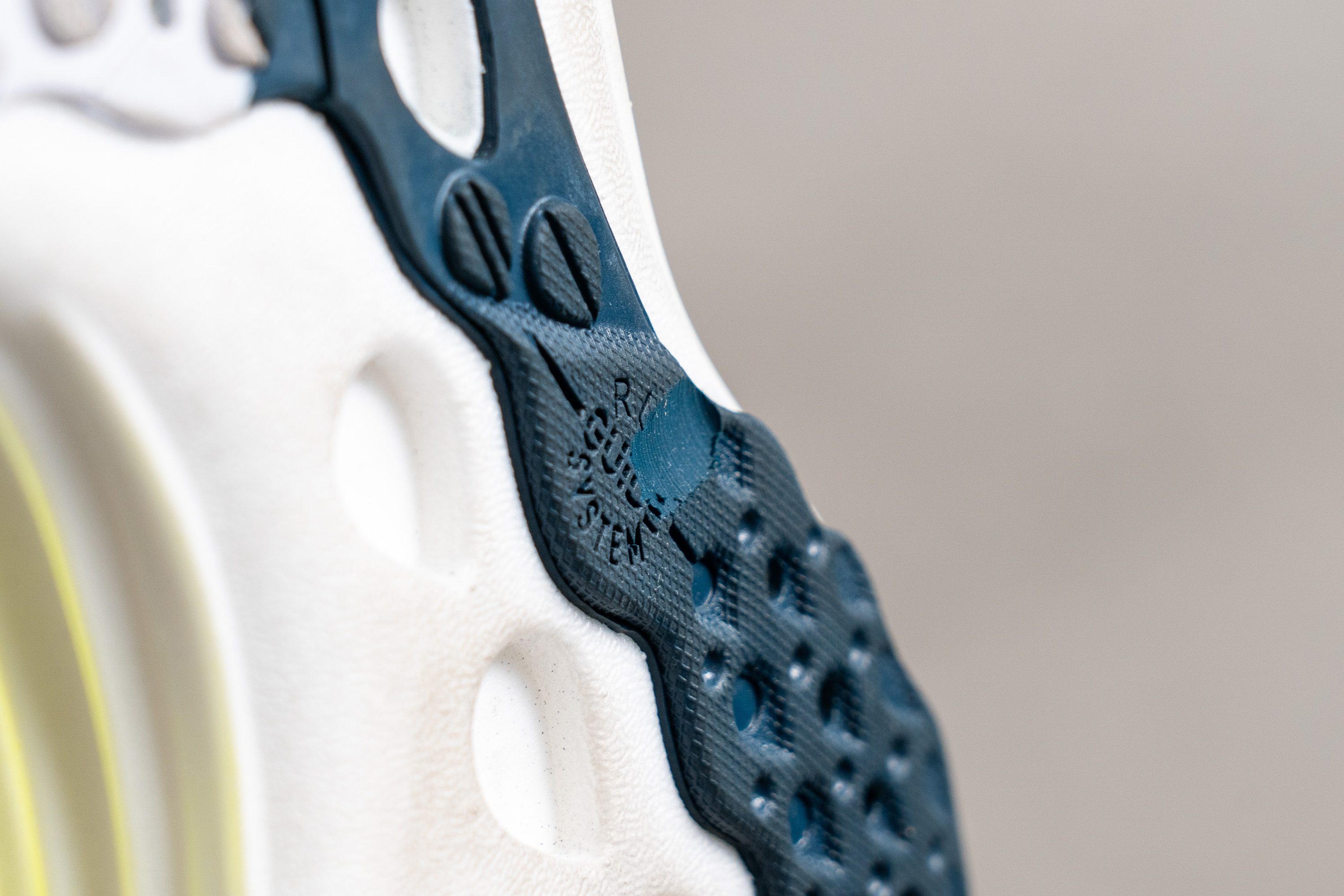
| ForeverRun Nitro | 1.8 mm |
| Media | 1.1 mm |
Grosor de la suela
PUMA era claramente consciente de ello, así que decidió utilizar una pieza de caucho de 4,5 mm de grosor en lugar de los 3 mm que solemos ver en el laboratorio.
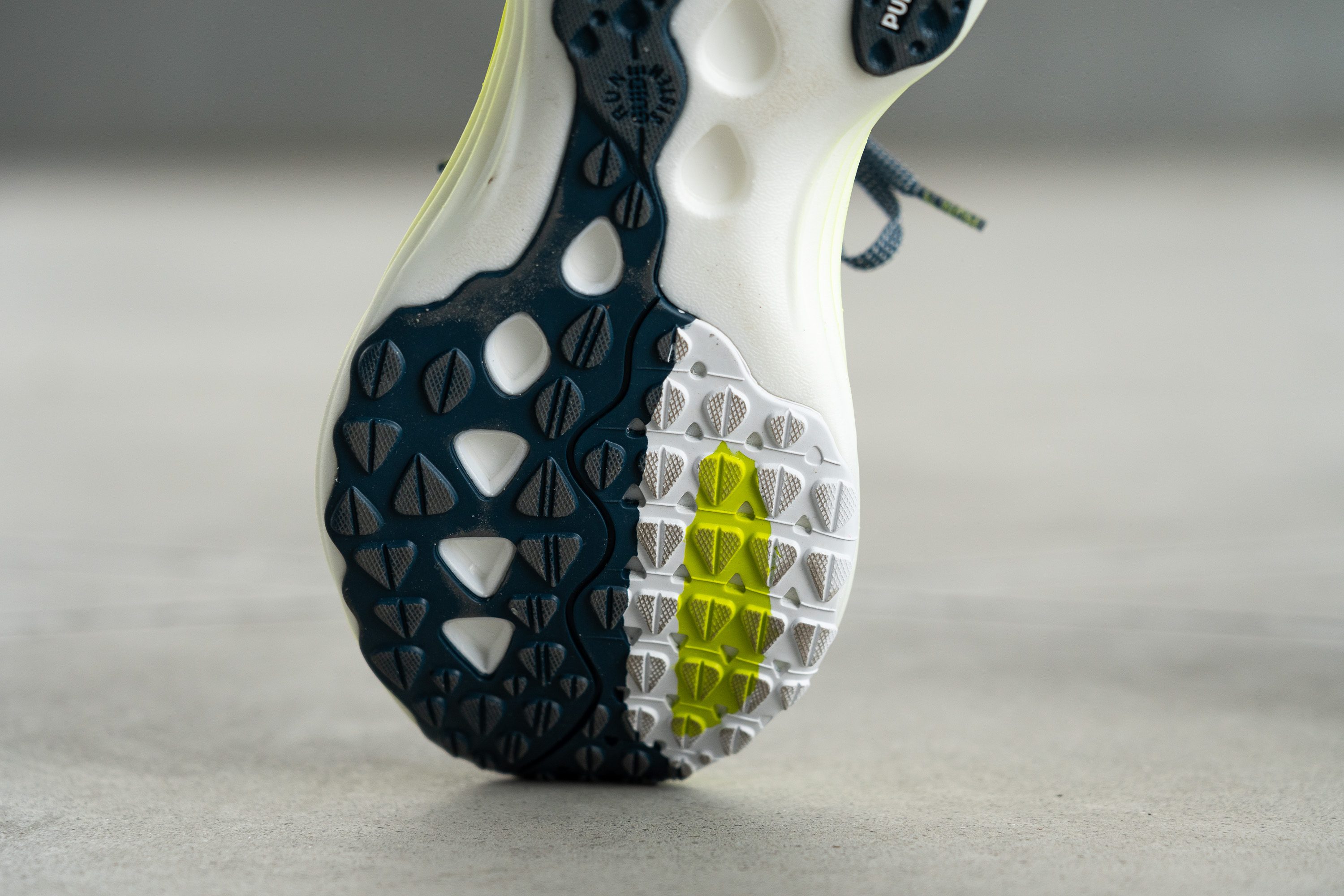
Vamos, que hemos comprobado que pretende compensar la terrible durabilidad de la suela exterior utilizando más caucho, esforzándose por conseguir un equilibrio entre un agarre excepcional y una vida útil reducida.
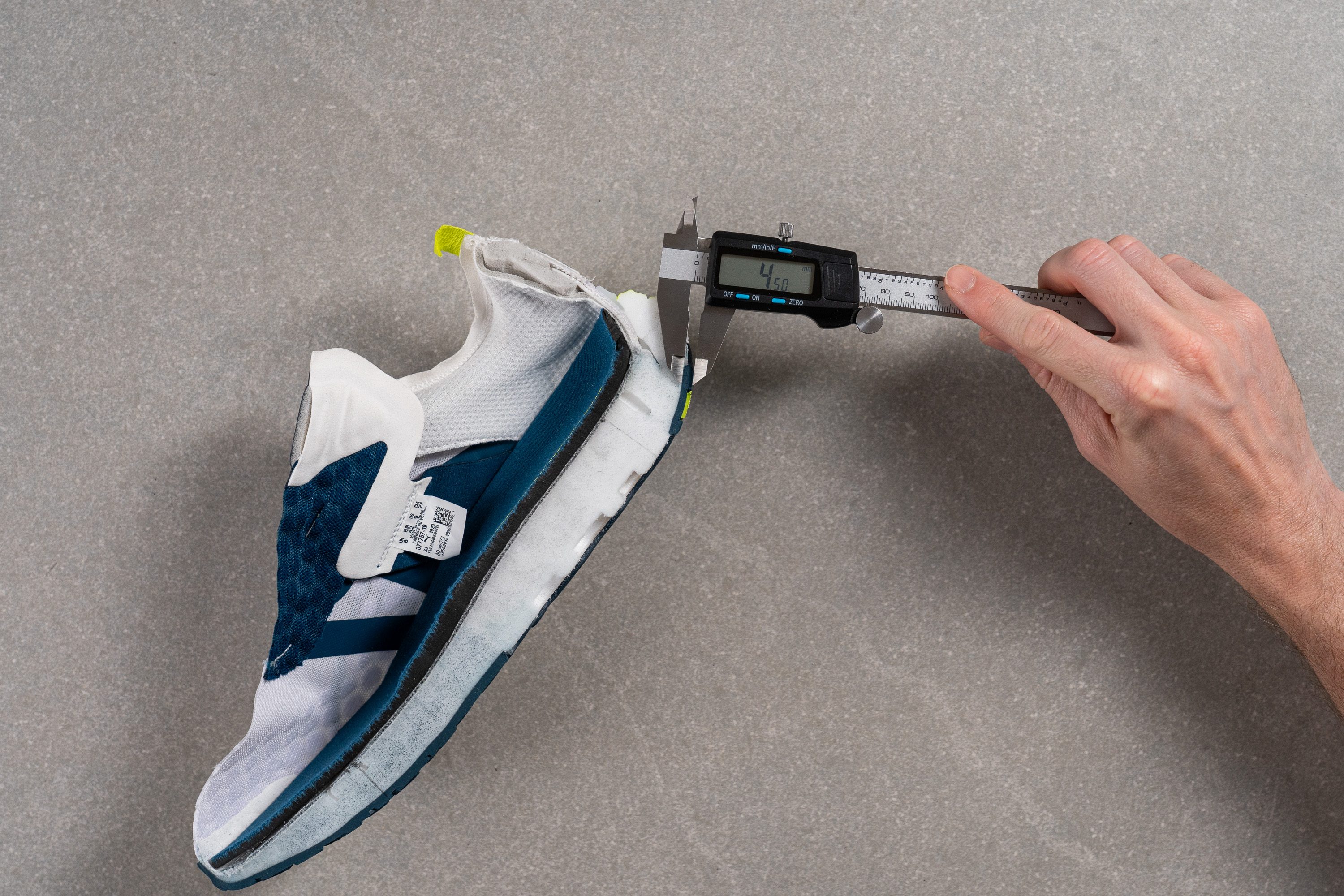
| ForeverRun Nitro | 4.5 mm |
| Media | 3.2 mm |
Varios
Grosor de la plantilla
La plantilla, fabricada por una empresa danesa en una colaboración poco habitual, es un poco más gruesa que la media con sus 5,3 mm, lo que nos da unos puntos extra de comodidad bajo los pies.
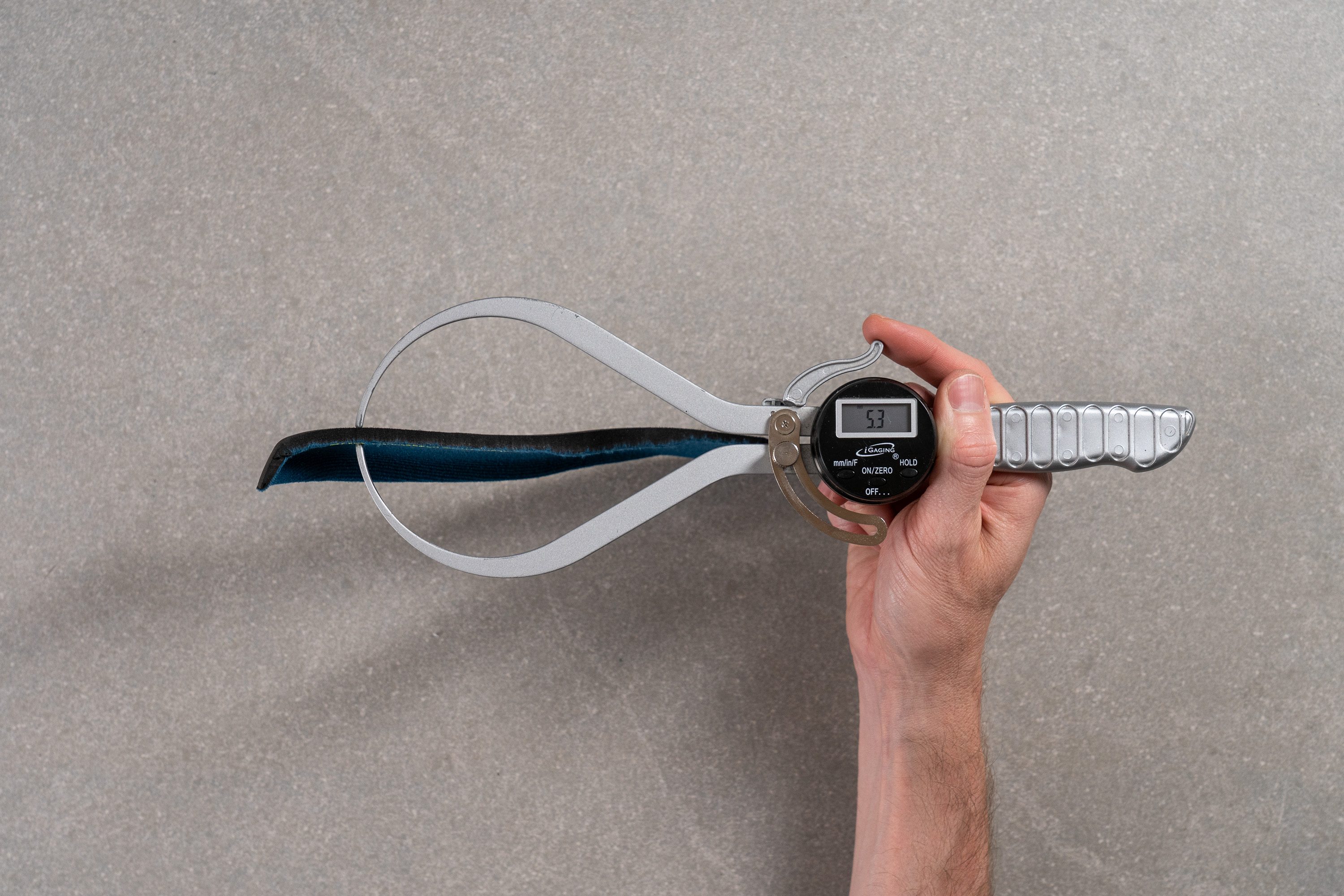
| ForeverRun Nitro | 5.3 mm |
| Media | 4.5 mm |
Plantilla extraíble
La plantilla no es de PUMA, sino de la empresa danesa Kaiser Sport & Ortopædi. Aunque la puedes cambiar, al hacerlo se pierde una de las características más únicas de estas zapatillas: la pequeña almohadilla metatarsal que tiene.
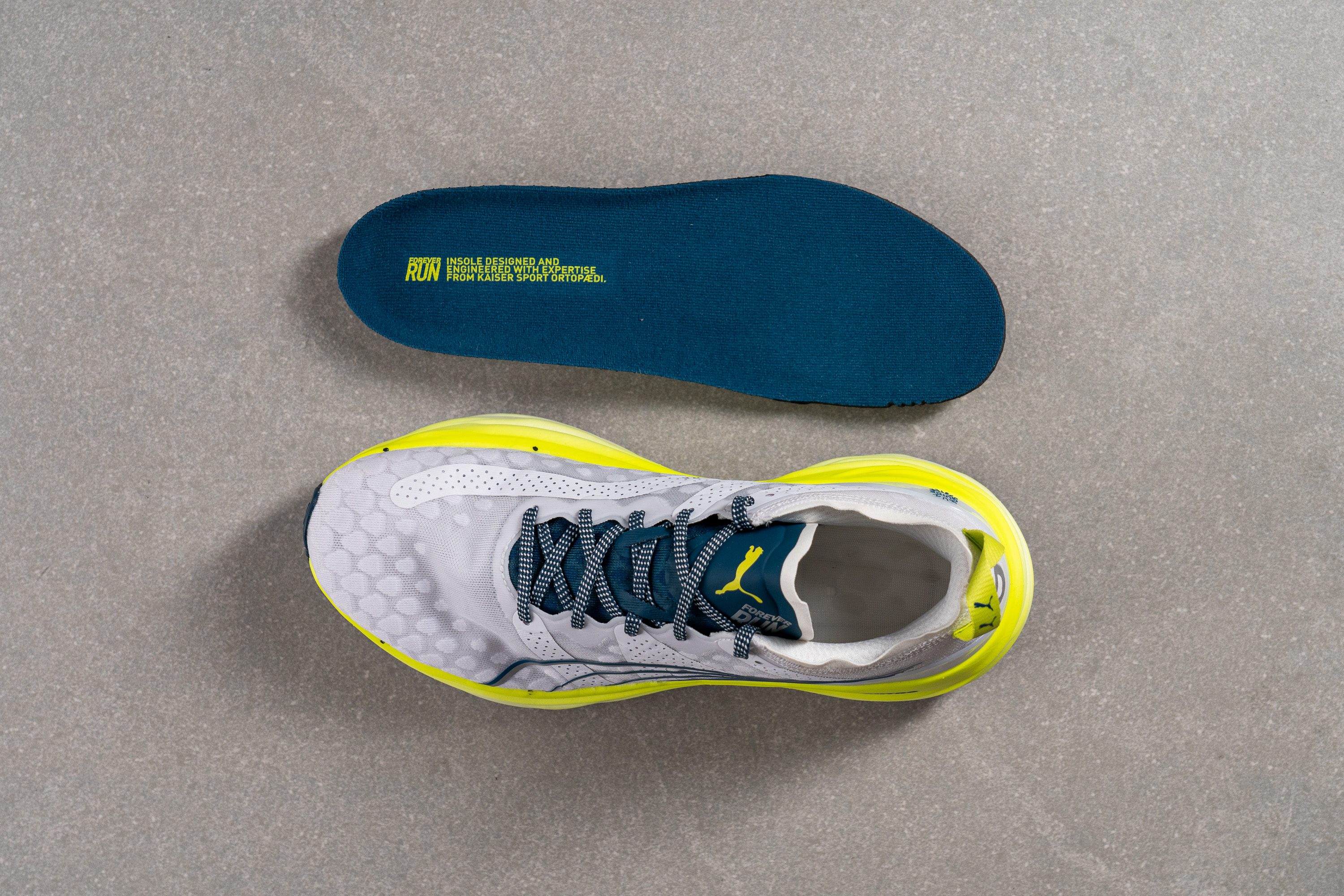
| ForeverRun Nitro | Sí |
Rigidez de la mediasuela en frío (%)
Después de meter las ForeverRun Nitro en nuestro congelador durante 20 minutos, volvimos a analizarlas con nuestro durómetro. La verdad es que los resultados no estuvieron nada mal, ya que el solo se volvieron un 18,9 % más rígidas.
Es algo que nos esperábamos, ya que la espuma Nitro, a diferencia de la EVA estándar, no se vuelve demasiado rígida cuando bajan las temperaturas.
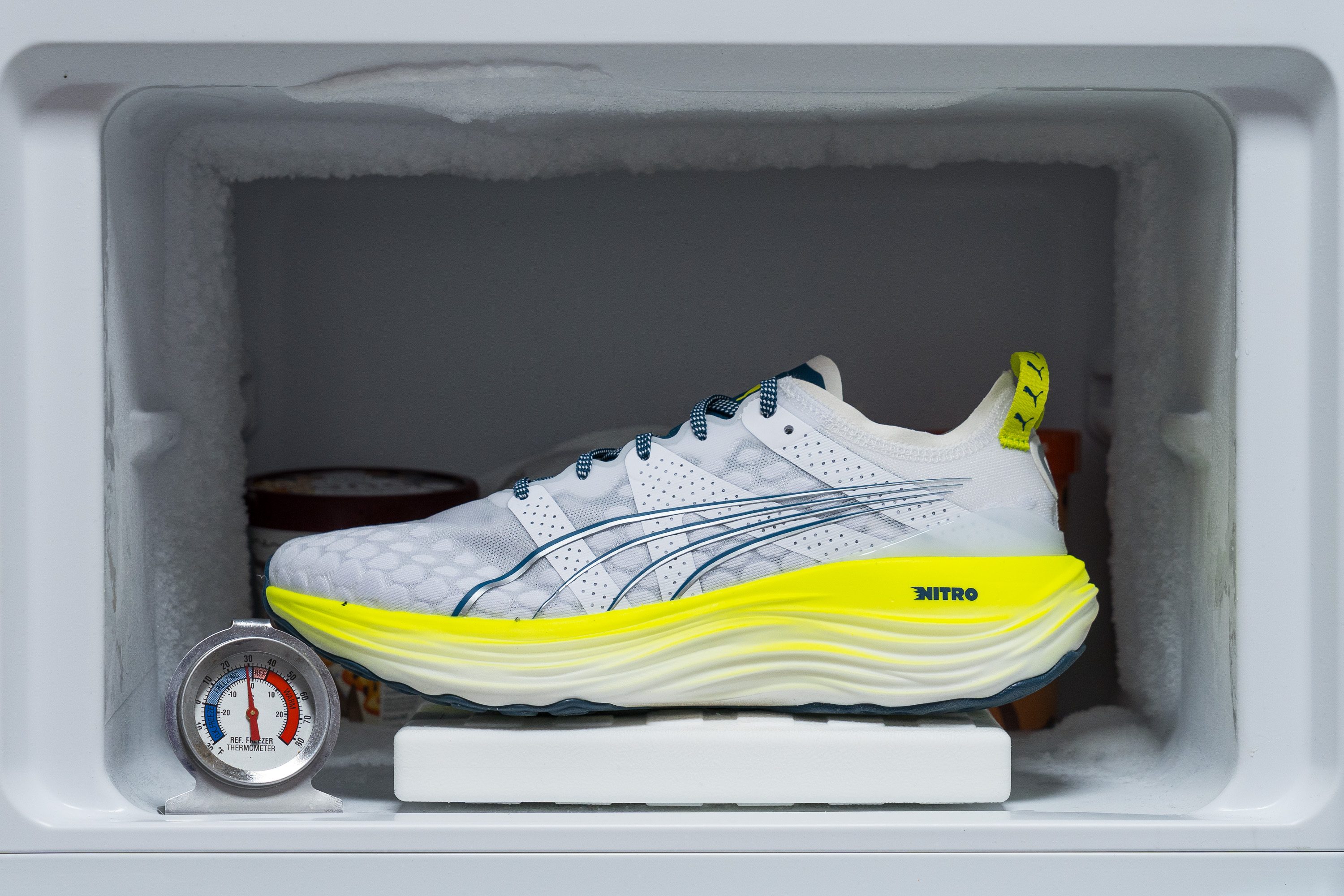
| ForeverRun Nitro | 19% |
| Media | 24% |
Elementos reflectantes
No hay muchas zapatillas de entrenamiento diario que tengan elementos reflectantes, pero hemos descubierto que las ForeverRun Nitro sí que cuentan con un par. No son los más llamativos que hemos visto, pero te ofrecen ese plus de seguridad.
| ForeverRun Nitro | Sí |
Acolchado de la lengüeta
La lengüeta de este modelo consigue ofrecer un equilibrio perfecto entre comodidad y peso. PUMA adoptó un enfoque inteligente, ya que añadió solo una almohadilla de 5,3 mm de grosor para proteger el empeine, dejando que el resto de la lengüeta fuese finita y aerodinámica, lo que redujo mucho el peso.
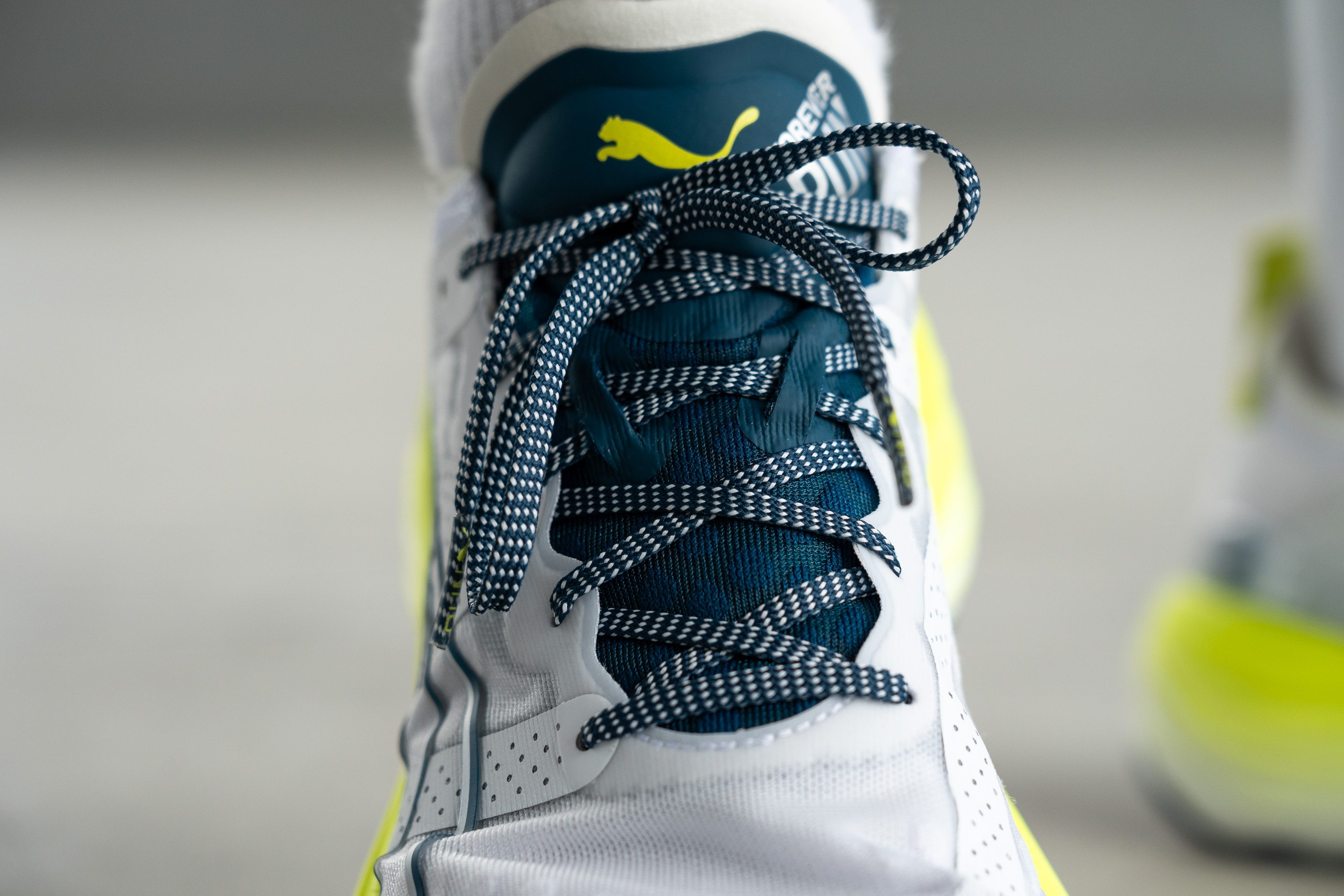
Este diseño no ofrece la comodidad de las lengüetas más acolchadas, pero consigue rebajar el peso sin dejar de ser cómodo. Vamos, que nos parece una decisión inteligente si estás buscando unas zapatillas más dinámicas.
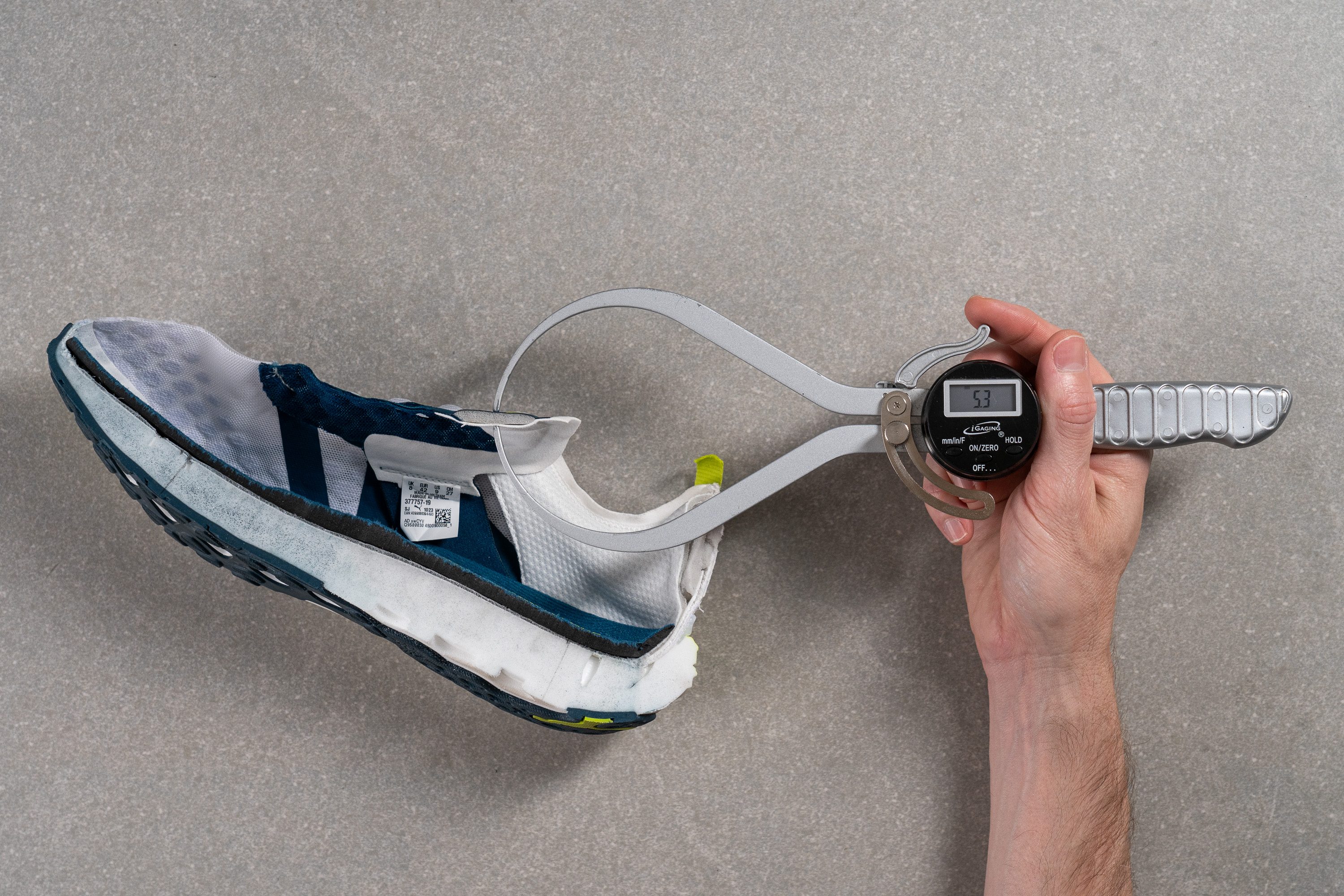
| ForeverRun Nitro | 5.3 mm |
| Media | 5.8 mm |
Lengüeta: tipo de refuerzo
La lengüeta está semi-reforzada, lo que significa que está parcialmente unida a los laterales, que es nuestro diseño favorito en las zapatillas de entrenamiento diario. Nos alegra ver que PUMA no ha escatimado en calidad en este aspecto, sobre todo porque es habitual que algunas marcas recorten gastos justo aquí.
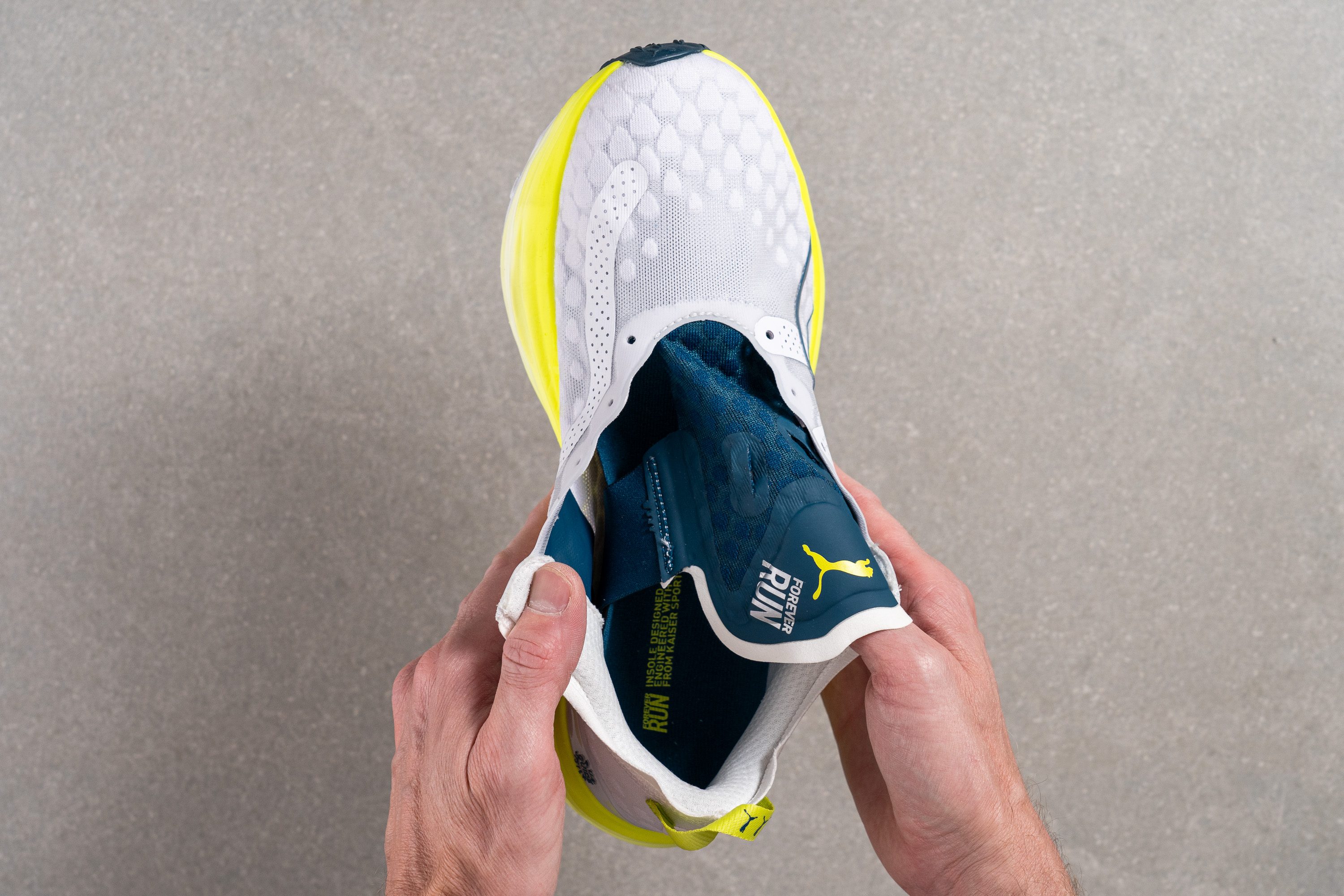
| ForeverRun Nitro | Ambos lados (semi) |
Precio
Creemos que las ForeverRun Nitro tienen un precio razonable, y aunque no sean una ganga, vienen llenas de ventajas. Son unas zapatillas de estabilidad bien amortiguadas, con una calidad de fabricación superior y materiales de primera, así que no nos vamos a quejar.
| ForeverRun Nitro | $150 |
Tirador del talón
Las ForeverRun Nitro tienen un tirador en el talón pero, la verdad... no nos ha gustado mucho. Creemos que es demasiado grande, y además no está hecho para durar. Pero bueno, es bastante práctico, solo que hay que tener cuidado al tirar.
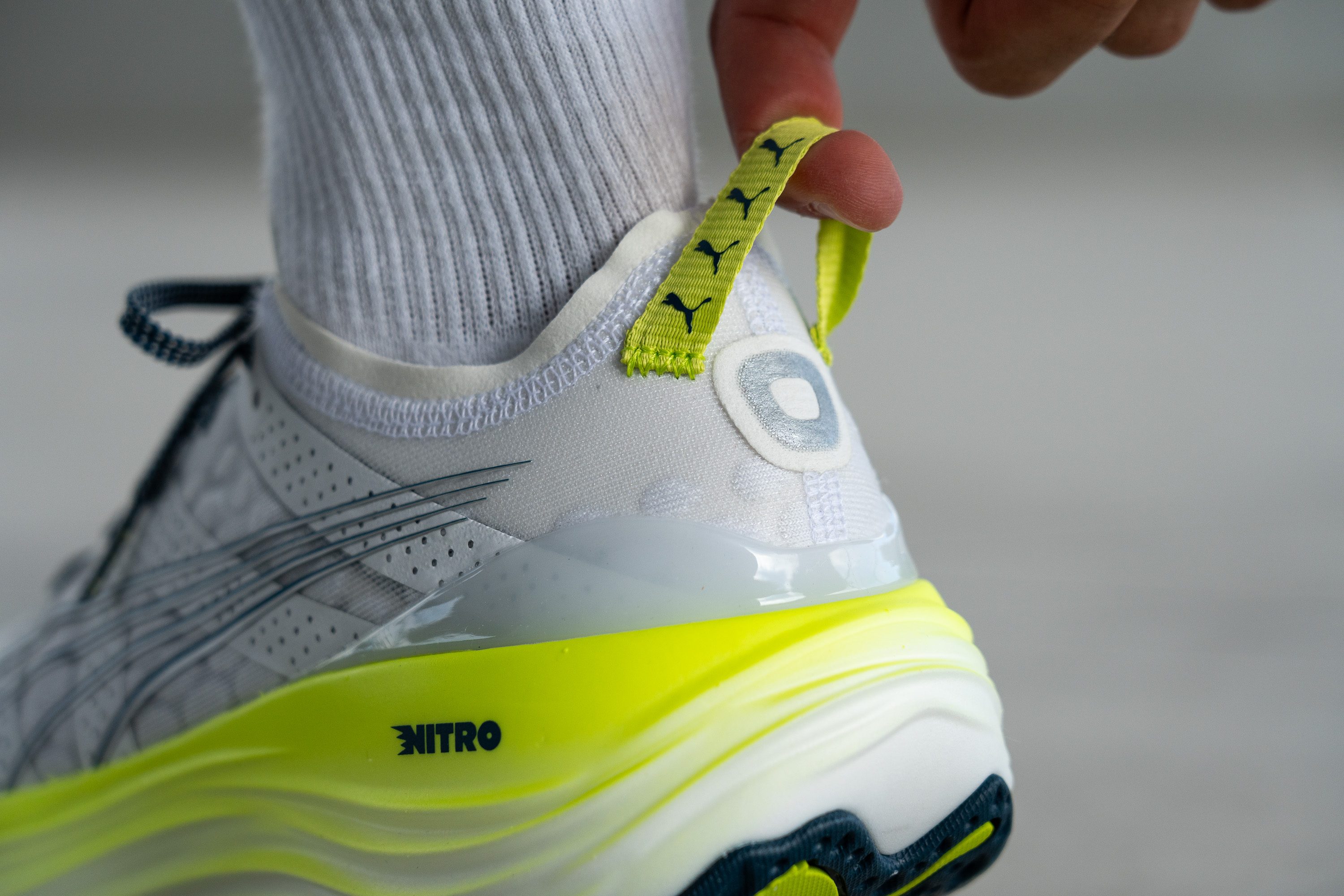
| ForeverRun Nitro | Tirador circular |


























































